




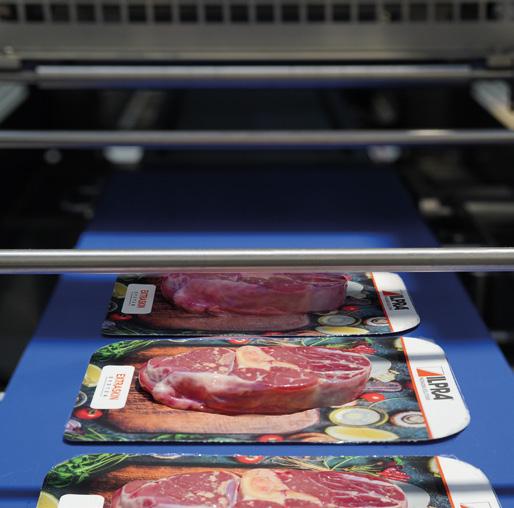
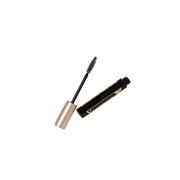

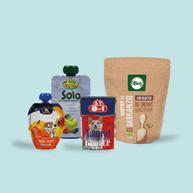
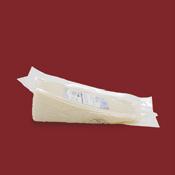


























































ILPRA GROUP The single destination for total packaging solutions. An extraordinary journey to the next exhibitions with the ILPRA GROUP, the Italian excellence in packaging. 10064 PINEROLO - ITALIA Tel. +39 0121393127 info@chiriottieditori.it www.foodexecutive.com Supplemento al n. 07, settembre 2023 di Industrie AlimentariSped. in A.P.D.L. 353/2003 (Conv. in L. 27/02/2004 n° 46) art. 1 comma 1 DCB TOn. 104 anno 2023IP n. 104 - September 2023 ISSN 1590-6515 FOOD
TECHNOLOGY ITALIAN
& PACKAGING
BULK-HANDLING SYSTEMS SINCE 1985
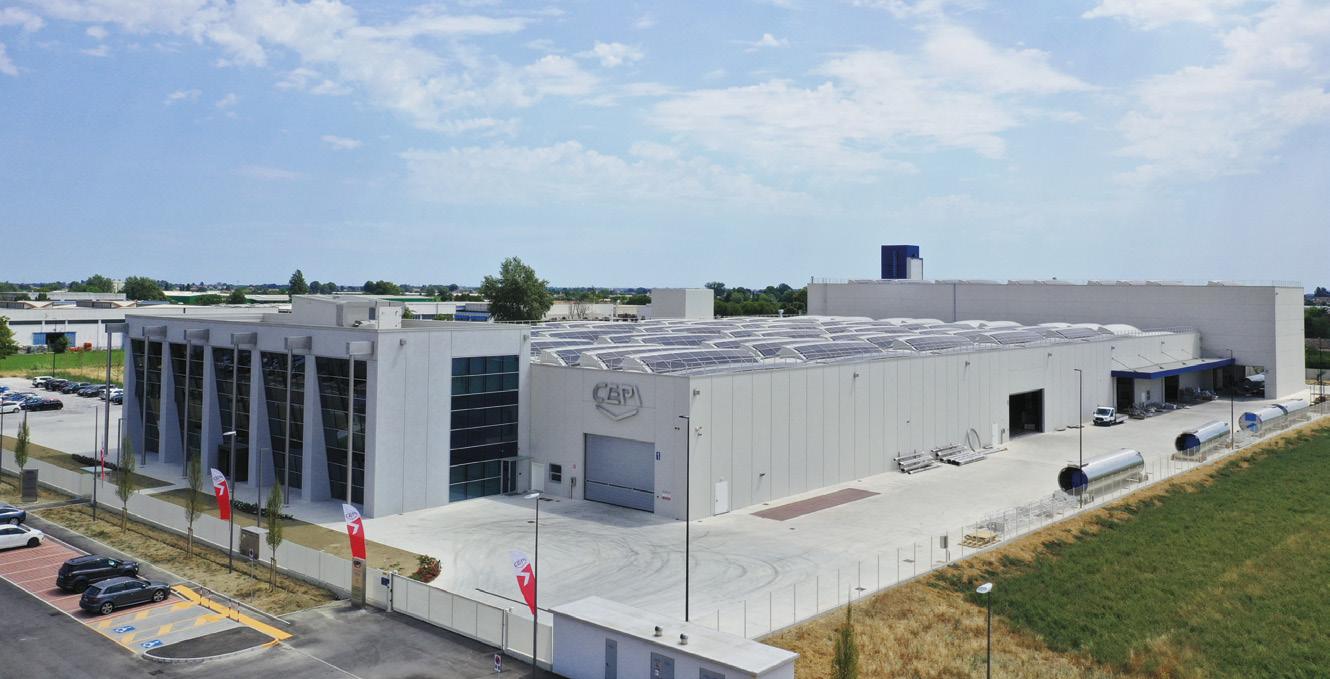
Turn-key, fully automated and customized

Process and product analysis
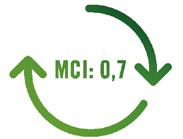
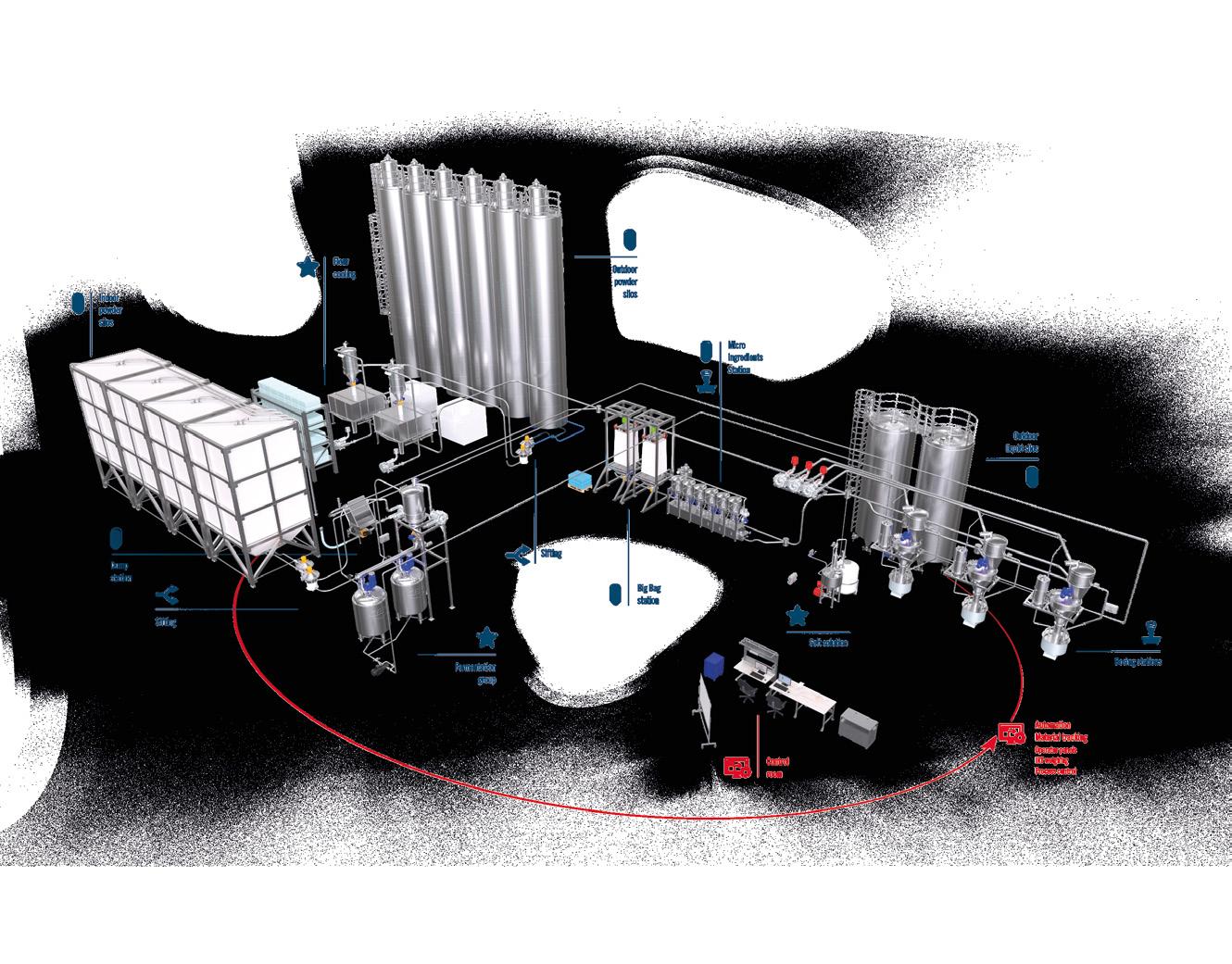
Engineering and control
Direct manufacture
Commissioning Service
cepisilos.com

linkedin.com/company/cepisilos
youtube.com/cepisilos
 22-26 October 2023 Munich Booth 354 Hall C1
22-26 October 2023 Munich Booth 354 Hall C1
CIRCULAR PRODUCT Suitable for reuse 83% Suitable for recycling 15% Recycling efficiency 84% Durability 30 years
STORING TRANSPORT DOSING AUTOMATION
departments
3
14
PRODUCT TRENDS - Mechanically separated meat market - Coffee: world markets and trade - World dairy markets and trade
FOOD PROCESSING - High quality stainless steel filters and pumps
- Dosing solutions - LM at Interpack with its “loops” - Innovation in jelly production - Pinsa line by Albaequipment - Megadyne food safety solution - Being refined is simple - Two-stage process for energy valorization of cheese whey - Decarbonizing process heat in the food and beverages industry - Impact of different processing techniques on the black truffle - Estimation of harvested fruit weight with distance sensors - Infrared and microwave alternate thawing method for frozen pork - Influence of low-pressure tumbling on the quality characteristics of thawed pork
28
34
PACKAGING TRENDS - Baked goods: Automated packaging for sensitive goods - The european market for carton board
PACKAGING EQUIPMENT - Digitalisation in the packaging process
- SMI solutions for Arden’s Garden juices - ILPRA Group: the single destination for total packaging solutions - New bioplastics based on polybutylene succinate (PBS) - Improving the sterilization of PET bottles
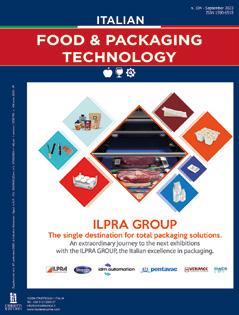
44
NUTRITION - Optimizing consumer acceptability of chocolate through roasting treatments - A novel mayonnaise-type dressing added with avocado pulp and oil - Developing a herbal drink from green asparagus - Effects of various milk powders on cocoa butter substitute-based chocolate - Saltiness enhancement of bread
48
RESEARCH - Rapid determination of the roasting degree of cocoa beans - New method to produce skim milk concentrateApplications of various natural pigments to a plant-based meat analog - Valorization of industrial spent coffee grounds - Protein modifications due to homogenisation and heat treatment of cow milk - Influencing factors of oil deterioration during frying
- Enhancing emulsifying and encapsulation properties of plant proteins - Effects of high hydrostatic pressure treatment on the digestive properties of whey protein - Thermal treatment of green barley malt to produce functional clean-label ingredients
- Decaffeination of coffee and tea using mid-infrared raysFeasibility of protein aerogel particles as food ingredient: the case of cocoa spreads - Effect of microfiltration on milk protein microstructure - Physical characterization of chocolates prepared with various soybean and milk powders
58 NEWS - Number of people facing acute food insecurity rose to 258 million in 58 Countries in 2022 - The NOVA project develops the next generation of antimicrobial coating technologiesInternational events in Italy - A revolutionary almond pasteThe meat industry will return to the spotlight in Milan in 2024
- Ipack-Ima Milano 2025: global technological excellence meets innovation
64 COMPANY INDEX SEPTEMBER - issue 104
Four-monthly - ISSN 1590-6515
September
issue 104
for free subscriptions
call to +39 0121 378147 or send an e-mail to:
abbonamenti@chiriottieditori.it
Chiriotti Editori s.r.l. Viale Rimembranza 60
10064 Pinerolo - To - Italia Tel. 0121 393127

info@chiriottieditori.it www.chiriottieditori.it
La riproduzione, anche parziale, di articoli ed illustrazioni pubblicati sulla rivista è riservata e non può avvenire senza espressa autorizzazione scritta dell’Editore. L’Editore non assume alcuna responsabilità per quanto riguarda eventuali errori contenuti negli articoli e per quanto espresso dagli Autori.
Publisher

Alberto CHIRIOTTI Direttore Responsabile alberto@chiriottieditori.it
Contributing Editors
Laura SBARATO, Simonetta MUSSO, Rossella CONTATO, Matteo BARBONI
Assistant Editor
Chiara MANCUSI mancusi@chiriottieditori.it
Graphics
Anna BOSCOLO
Marketing Manager
Monica PAGLIARDI pagliardi@chiriottieditori.it
Advertising Manager
Luca RUSSO russo@chiriottieditori.it
General Manager
Giuseppe CHIRIOTTI
All Rights reserved. Reproduction, even partial, of articles and illustrations published in the journal is forbidden and can not take place without written permission of the Publisher. The Publisher assumes no responsibility for any errors contained in the articles and for what is expressed by the Authors and/or by the companies.
PRINTED by Graf Art
Officine Grafiche Artistiche Venaria (To)
COPYRIGHT:
© 2023 Chiriotti Editori srl Supplemento del mensile
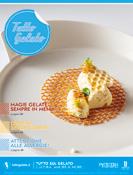
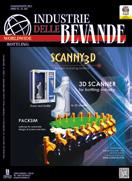
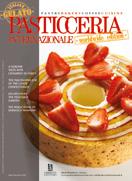
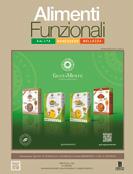

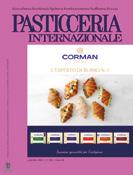

“Industrie Alimentari”
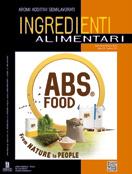
AUTORIZZAZIONE: n. 262 (19-11-1962)
del Tribunale di Pinerolo
PERIODICITÀ:
mensile - sped. in A.P. comma
20/B, art. 2, legge 662/96Torino
INTERNET:
www.chiriottieditori.it


Unione Stampa Periodica Italiana Copyright Clearance Center
www.chiriottieditori.it shop.chiriottieditori.it www.foodexecutive.it
www.tuttogelato.it
OUR WEBSITES
www.pasticceriainternazionale.it
www.alimentifunzionali.it
PRODUCT TRENDS
Mechanically separated meat market
Companies involved in the mechanically separated meat industry are trying to optimize their production facilities by incorporating new technologies and adhering to guidelines while obtaining certifications to ease consumer concerns. The frozen segment occupies a major market share due to the prevalence of a highly extensive fast food industry that relies primarily on frozen meat for consumer consumption. The manufacturers should take the opportunity to invest and place similar focus on keeping up a steady supply for fresh meat consumers instead of targeting a single segment. Similarly, focus should be placed on increasing brand presence in markets with lower share due to their untapped potential. Survey of such markets to understand the needs of the consumer while adapting and evolving production lines can help companies maximize their profits while diversifying product offerings.
Market overview
The substantial growth in the demand from the meat industry, increasing production capacity, and high capital investments contribute to filling the supply & demand gap. Some of the major driving factors for the mechanically separated meat market include high nutritional value, minimal space requirements, and low environmental impact, due to which the market is estimated to grow rapidly.
According to this latest report published by Transparency Market Research, the global mechanically separated meat business register a high growth
rate during the forecast period 2022-2032, due to its high demand from consumers and growth in the fast food & ready to eat industry. In terms of revenue, the global mechanically separated meat industry is expected to reach a valuation of US$ 369.3 Mn by the year 2032, growing at a CAGR of 4.2% during the forecast period.
Rising demand for poultry meat fueling the growth of the global mechanically separated meat market
The increasing demand for poultry meat from emerging countries such as China, Mexico, and India, owing to market manufacturers expanding their sales footprint across these regions, is triggering the demand for mechanically separated meat.
Frozen mechanically separated poultry meat offers numerous benefits, including prolonged shelf life and food safety, which is projected to boost the global market throughout the forecast period. Furthermore, frozen mechanically separated meat products are simple to prepare and help reduce food waste.
Manufacturers anticipating a constant growth in demand for halal meat
The demand for halal meat, which is an integral part of the Muslim lifestyle, is increasing significantly. Nearly all types of meat in the Middle East and North Africa region are halal by default; however, in AsiaPacific, which also has a sizable Muslim population, demand for halal-certified products is increasing.
Furthermore, growing demand for halal meat is seen in several European nations, including the
italian food & packaging technology - civ (2023) - september 3
UK, France, and Germany. Turkish or Arabic-focused companies take benefit of these opportunities by selling meat that has received the halal certification. Consequently, halal meat sales have increased throughout the continent of Europe.
Growing demand for frozen meat creates opportunities for producers to make novel innovations

The global demand for frozen foods has skyrocketed, owing primarily to the trend of food traceability among new-age customers seeking healthy options. Due to the convenience component, consumers in various regions are expected to invest more in frozen foods.
Rapid developments in freezing techniques to prolong the lifespan of meat products without compromising quality are driving frozen meat sales in the mechanically separated meat sector. Thus, the rising customer demand is anticipated to motivate manufacturers in the mechanically separated meat industry to develop cutting-edge innovations in terms of appearance, taste, and packaging to increase the adoption of frozen meat products.
One of the key factors influencing consumer demand for convenience foods is shelf life. The distribution and supply of products are made easier and more effective by a product’s prolonged shelf life. Retailers are responding to the increasing working population and fast-paced life by increasing shelf space for food offerings in their stores. This is anticipated to increase the demand for ready-to-eat food offerings over the forecast period, resulting in increased demand for frozen meat.
Manufacturers in emerging economies can capitalize on waste processing and value addition
Meat processing manufacturers in developing economies can embark on the extension of their processing facilities to further add value to the waste generated. It is estimated that the livestock industry generates 1.4 billion pounds of waste annually – this dire statistic represents a sizeable untapped opportunity.
Deboning operation is a waste valorization concept that can result in significant income generation for small to medium-scale meat processors in the emerging markets of Asia Pacific and Latin America. The deboned meat along with other associated ingredients can further facilitate in improving the cyclic economy in this sector.
Regular consumption of meat to provide lucrative opportunities to msm manufacturers
Regular meat consumption can result in a variety of ailments. Regular consumption of red meat, poultry meat, and processed and unprocessed meat causes a number of diseases. Due to the accompanying health issues, producers have been obliged to develop alternate products for consumers who do not want to compromise on taste and texture. Thus, product diversification in their portfolios will provide lucrative opportunities to the manufacturers in the market.
According to a study conducted by the University of Oxford, it has been observed that higher consumption of poultry meat, unprocessed red meat, and processed meat was associated with a higher risk of pneumonia, diabetes, ischemic heart disease, diverticular disease, gastroesophageal reflux disease, and gallbladder disease, among others.
Poultry segment to lead the market: type segmentation
The poultry segment is expected to occupy a market value share of 61.5% in 2032 and is currently valued at US$ 144.5 Mn. The market was divided into poultry, beef, and pork segments where pork holds a greater potential as compared to the beef segment. The beef segment has the lowest forecast CAGR of 3.0%.
4 italian food & packaging technology - civ (2023) - september product trends
Frozen form of mechanically separated form segmentation
The form segment is subdivided into fresh and frozen which currently holds the major market share of around 63%. The likely reason for this is due to the easy transportation of frozen foods when compared to its counterpart. The rise in fast food consumption like burgers and other bite-sized foods presents the highest opportunity for market growth.
Geographic outlook
The highest value share is held by Europe followed by North America and East Asia at approximately 29%, 19%, and 16% respectively. The highest forecast value CAGR was in the East Asian region at 6%.
In the European region, Germany has the current highest value of US$ 13.97 Mn, and Russia is expected to show the highest growth in the upcoming years.
North America also holds a pretty large share of the mechanically separated meat market, with the U.S. occupying 88.7% of the current market share. China accounts for the highest value in the East Asian region of about US$ 18.25 Mn and is expected to rise at a CAGR of 6.5% and reach a valuation of US$ 34.35 Mn in 2032.
Major Players Analysis
The global mechanically separated meat market is expanding rapidly and major players are putting in the effort to provide consumers with the desired products. Customers are gradually becoming aware of unhealthy cultivation practices, focusing on clean and healthy food. Increasing regional supply and ontime delivery of products is paramount in order to placate consumer demand while collaboration with key players in the same industry is being adopted by the companies to increase brand presence and have greater footprints in emerging markets. Attending conferences while showcasing new products helps companies highlight their innovations in order to gain consumer attention and loyalty. The major players in the industry are Tyson Foods, Inc, J.A. ter Maten B.V., Belwood Foods, and Polskamp Meat Industry holding 55%-65% of the market.
Global market: key developments
Belwood Foods invests heavily in new ideas and technologies to ensure product innovation and meet the increasing consumer demand for its products. For instance, with efficient manufacturing, the company maintains the same high standards in its pro-
duction and supply to its customers on time around the world.
In 2018, Damaco group made a huge investment in infrastructure and production at the Kipco-Damaco headquarters. The company is focusing on sustainability, the quality of its products, and delivering to its customers in a timely manner.
DTS Meat Processing NV works collaboratively with renowned MDM processors worldwide to offer natural products to its customers, mainly in the meat industry. The company strives to establish strong, mutually beneficial business relationships with suppliers and customers.
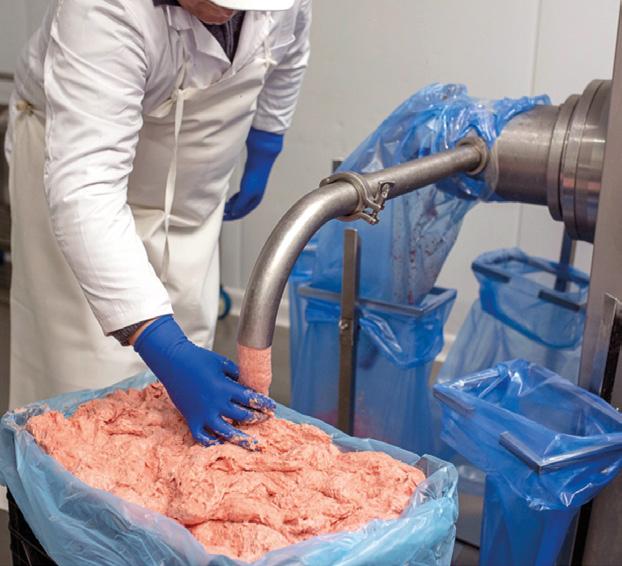
In October 2020, Trinity GMBH participated in conferences & expos in the Netherlands. The company showcased its MDM and other products at Sial 2020. Local experts communicated with customers about the trends and opportunities of mechanically deboned meat.
The players mentioned above have been profiled in the global mechanically separated meat market report based on numerous parameters that include business strategies, financial overview, business segments, company overview, product portfolio, and recent developments.
italian food & packaging technology - civ (2023) - september 5 product trends
www.transparencymarketresearch.com
Coffee: world markets and trade

According to the Foreign Agricultural Service of USDA, world coffee production for 2023/24 is forecast 4.3 million bags (60 kg) higher than the previous year to 174.3 million. Higher output in Brazil and Vietnam is expected to more than offset reduced production in Indonesia. With additional supplies, global exports are expected up 5.8 million bags to a record 122.2 million primarily on strong shipments from Brazil. With global consumption forecast at a record 170.2 million bags, ending inventories are expected to remain tight at 31.8 million bags.
Brazil
Combined Arabica and Robusta harvest in Brasil is forecast up 3.8 million bags to 66.4 million in 2023/24. Arabica output is forecast to improve 4.9 million bags to 44.7 million. In January 2023, coffee trees in top growing region Minas Gerais experienced higher than average rains during the fruit development stage that caused difficulties for some growers in controlling plant diseases and pests. However, increased precipitation resulted in coarser and heavier beans compared to the last crop, which contributed to production gains. Although output is expected to expand, this quantity is below previous crops that peaked at nearly 50 million bags. Arabica trees in many growing regions continue to recover from severe frosts, high temperatures, and below-average rainfall that occurred in 2021 that lowered production in 2021/22 and 2022/23. Following 6 years of expansion, the Robusta harvest is forecast to decline 1.1
6 italian food & packaging technology - civ (2023) - september product trends
million bags to 21.7 million as reduced rains and cooler temperatures leading up to the flowering stage lowered yields in Espirito Santo, where the vast majority is grown. Coffee bean exports are forecast to rebound 8.0 million bags to 41.0 million, fueled by higher supplies and an expected stocks drawdown.
Vietnam
Vietnam production is forecast to rebound 1.6 million bags to 31.3 million due to higher yields attributed to favorable weather. Cultivated area is forecast unchanged, with nearly 95% of total output remaining as Robusta. Bean exports are forecast to decline 1.5 million bags to 24.5 million, with output gains boosting ending stocks to 2.7 million bags.
Central America
Central America and Mexico production is forecast nearly unchanged at 17.9 million bags, with Arabica accounting for 95% of total output. Modest gains in Honduras, El Salvador and Costa Rica are expected to
offset a slight dip in Guatemala. Bean exports for the region are forecast nearly flat at 14.7 million bags on steady shipments to top markets.
Colombia
Arabica production in Colombia is forecast up 300,000 bags to 11.6 million on slightly higher yields. Despite rising, yields remain nearly 15% below normal because growers limited fertilizer use due to its price spike. Bean exports, mostly to the United States and European Union, are forecast up just 100,000 bags to 10.9 million as supplies remain tight.

Indonesia
Combined Arabica and Robusta harvest in Indonesia is forecast down 2.2 million bags to 9.7 million. Robusta production is expected to drop 2.1 million bags to 8.4 million. Excessive rain during cherry development lowered yields and caused sub-optimal conditions for pollination in the lowland areas of Southern Sumatra and Java, where approximately 75% is grown. Arabica production is seen dipping slightly to 1.3 million bags. Bean exports are forecast to plummet 2.5 million bags to 5.2 million on sharply reduced supplies.
Ethiopia
Arabica production in Ethiopia is forecast nearly flat at 8.4 million bags and remains the world’s third-largest Arabica producer behind Brazil and Colombia. Yields have been stubbornly stuck around 14 bags per hectare while other top Arabica producers average yields that are 40-60% higher. Improved crop management practices have not been widely adopted because 95% of production occurs on non-commercial plots typically one- half hectare or less. Few non-commercial growers are interested in incurring investment costs due to the informal nature of their growing method, while commercial growers note that 5 to 10 years are needed to realize a return on their investment. Yields are also low due to limited use of fungicides despite the presence of coffee berry disease, coffee wilt disease, and root rot disease. Bean exports are forecast unchanged on stable supplies.
India
India combined Arabica and Robusta harvest is forecast to decline 400,000 bags to 5.8 million. Robusta production is forecast to drop 300,000 bags
italian food & packaging technology - civ (2023) - september 7 product trends
to 4.6 million due primarily to a prolonged dry spell from December 2022 to March 2023 which was followed by poor pre-monsoon rains. Arabica production is seen slipping 100,000 bags to 1.2 million. Bean exports are forecast up just 100,000 bags to 4.3 million on a slight inventory drawdown.
European Union
European Union imports are forecast up 3.0 million bags to 47.5 million and account for 40% of the world’s coffee bean imports. Top suppliers in calendar year 2022 included Brazil (35%), Vietnam (22%), Uganda (7%), and Honduras (6%). Ending stocks are expected to rise 500,000 bags to 13.1 million.
The United States
The United States imports the second-largest amount of coffee beans and is forecast to gain 2.5 million bags to 26.5 million. Top suppliers in calendar year 2022 included Brazil (31%), Colombia (19%), Vietnam (10%), and Guatemala (6%). Ending stocks are forecast up 1.1 million bags to 6.8 million.


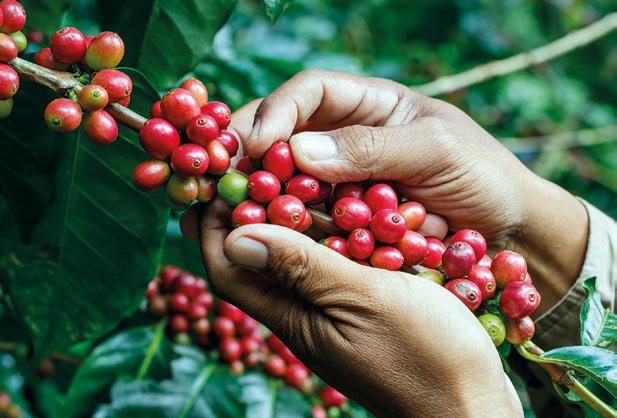
World production
World production is lowered 2.7 million bags from the December 2022 estimate to 170.0 million and the world ending stocks are revised down 2.5 million bags to 31.6 million.
www.usda.gov
8 italian food & packaging technology - civ (2023) - september product trends
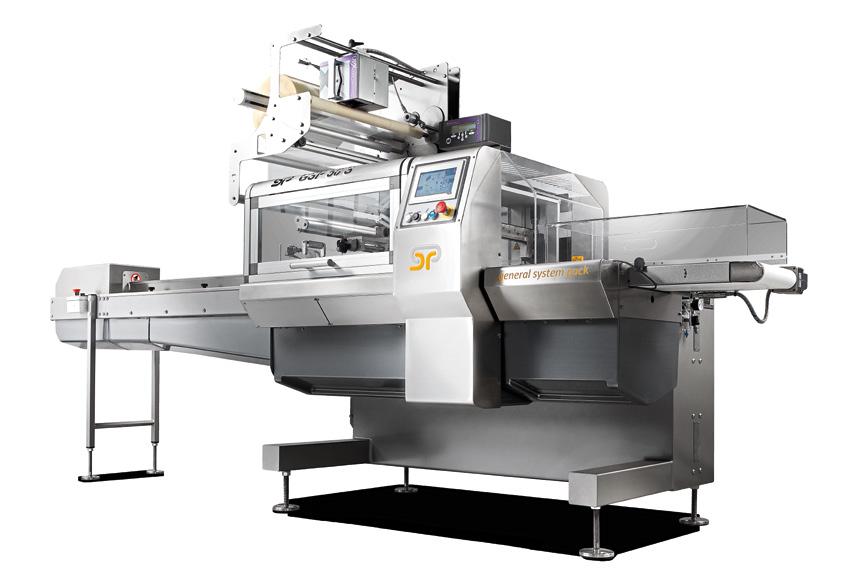
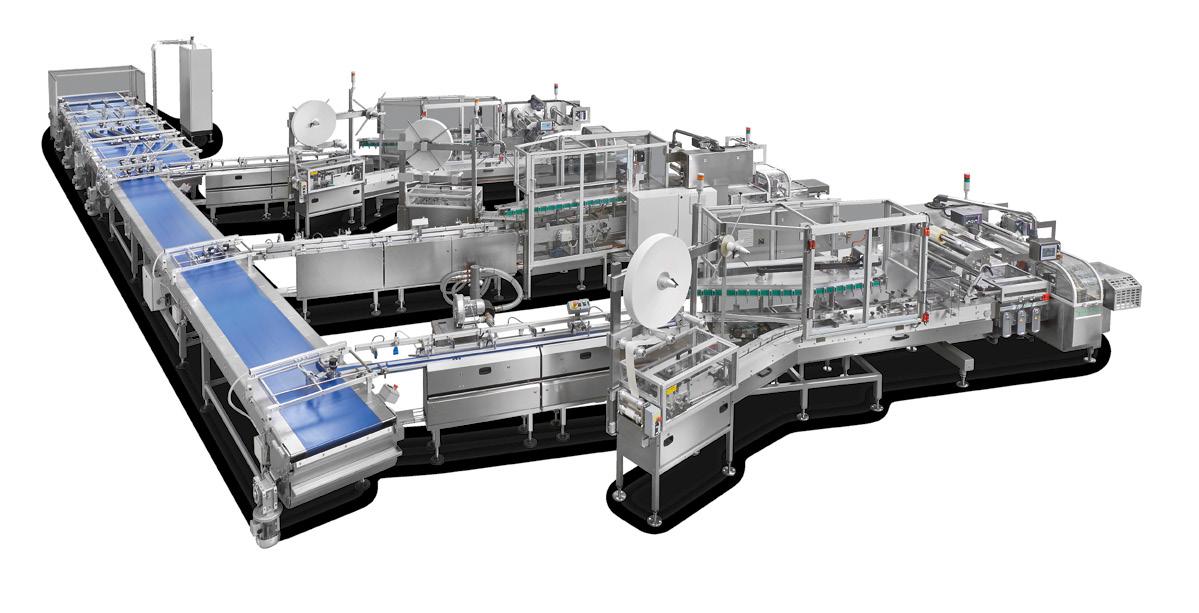

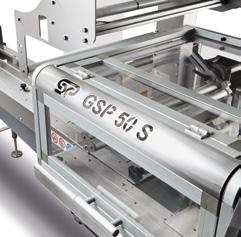

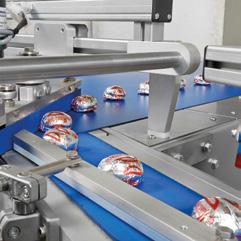

World dairy markets and trade
According to the latest report by the Foreign Agricultural Service of USDA , resilient global milk production, currently on a 10-month streak of annual gains on a monthly basis dating back to last July, has put downward pressure on prices of manufactured dairy commodities. Through May, exports of dairy products on a value basis to Southeast Asia have totaled $561 million, down 33% from the same period last year. There have been broad declines across multiple commodities, including skimmed milk powder, whey and cheese. This is coming in a period where SMP prices are down 37% and whey prices are 52% from the peak in February 2022.
As the world enters a post-COVID lockdown world, governments are now under pressure to reign in fiscal spending and combat high food inflation, which have reached an all-time in high in many countries in the region, typically done via higher interest rates. In the Philippines, food inflation reached 11%, driven by increases in dietary staples like vegetables. Increasing food costs have forced consumers to reduce discretionary spending (a category which includes spending on dairy products which are not a major part of traditional diets). Lower discretionary spending is impacting both the restaurant industry and retail purchases. Demand for whey and lactose has also fallen in several countries. In Vietnam, swine herds continue to recover from African swine fever, reducing demand for whey and lactose for feed use (export volumes to Vietnam for both products are down 11 and 23%, respectively). In the Philippines, another market that has been impacted by ASF, exports of whey and lactose have fallen 26 and 9%, respectively. There also continue to be regulatory pressures in Southeast Asia hindering U.S. dairy exporters this year, specifically halal certifications processes.
The development of dairy exports on the global market has been one of the biggest success stories for U.S. agriculture over the last 2 decades. Growth in the Southeast Asia market has been an important factor in expanding exports from $1 billion in 2003 to $9.5 billion in 2022 (dairy exports to Southeast Asia totaled $1.7 billion in 2022, the third largest regional market in the world for dairy exports behind North America and East Asia). U.S. dairy exporters have captured sizeable market share, but stiff competition continues from Oceania and the European Union, which benefit from long-standing trading infrastructure in the region and tariff advantages granted in free trade agreements. The recently established Indo-Pacific Economic Framework for Prosperity (IPEF) is a potential avenue to gaining similar advantages for U.S. agriculture in the region.
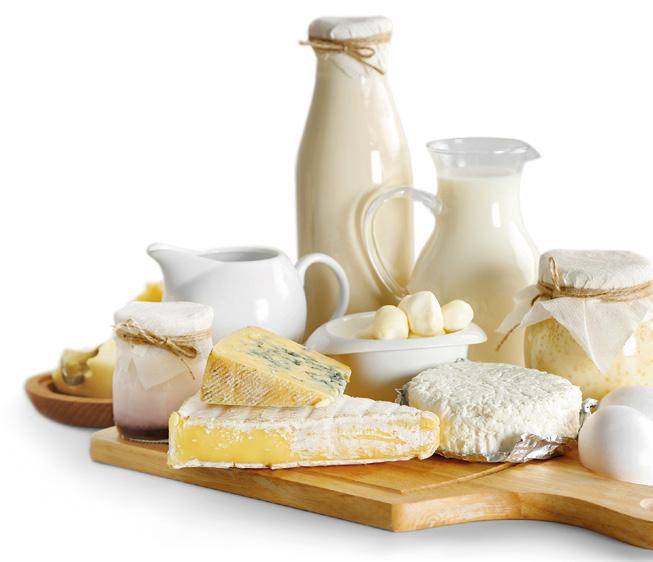
10 italian food & packaging technology - civ (2023) - september product trends
FLUID MILK
In Argentina, milk production is forecast to decline 3% as severe drought has resulted in poor forage conditions and expensive, poor-quality hay. In addition, significant peso depreciation continues to hover over dairy production. In the past, strong depreciation in the peso has corresponded with declines in milk production because most inputs, mainly concentrates, are dollar denominated, and their prices are set by the open market. Meanwhile, the price of milk, of which nearly 80% is destined for domestic use, can take several months to adjust to the new dollar value and compress margins in the near term for producers.
Milk production in Australia is forecast to decline to 8.2 million tons for 2023. Extreme Spring rains resulted in a shortage of hay supplies and strong beef prices in recent years continues to incentivize dairy farmers to shift to beef production, with the dairy herd size forecast to shrink 0.7% to 1.325 million cows. Producers are also still grappling with labor shortages that stem from COVID-related border crossing restrictions in 2020 that reduced the number of visa approvals for holiday and backpacking travelers, a historical source of on-farm workers. Since Australia has re-opened its borders, finding on-farm labor has become easier, but on-farm labor has not returned to pre-pandemic levels. To make up the gap in fewer employees, dairy operations have turned to different production practices that naturally depress milk output, including decreasing daily milkings from three to two or converting to ten milkings per week. As a result, milk yields are forecast to fall 2.3%. These factors offset otherwise favorable conditions for milk production including strong milk prices, improved water availability, and high quality, affordable domestic feed.
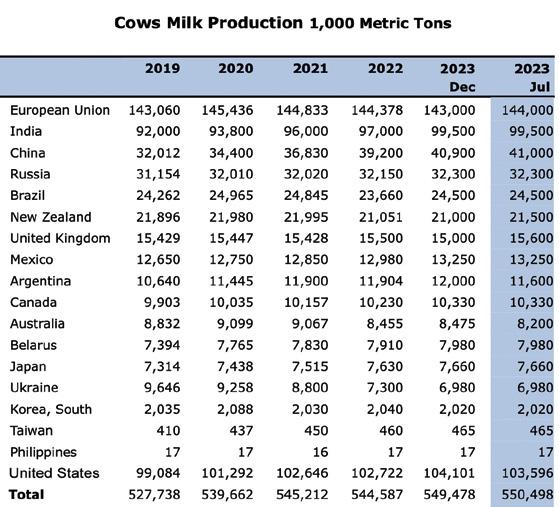
European Union milk production is forecast relatively unchanged, marginally declining to 144.0 million tons. Milk production grew during the first 5 months of the year due to year-over-year increases in productivity, despite a decline in the milk herd of over 100,000 cows. However, newly implemented environmental and animal welfare policies introduced in many EU member states have contributed to herd size reduction and have stressed growth in yields that have previously helped continue to grow the milk pool. In particular, dairy cow numbers are expected to decline in the Netherlands, which capped nitrogen usage for pasture production and banned
farmers from spreading manure on fields as fertilizer. Complying with the new regulations puts producers in a dilemma: either invest large amounts of capital to adopt new production processes or shift production to beef and increase slaughter. Declining EU farmgate milk prices and increasing cost of production –higher feed, energy, and labor costs – have also accelerated exits from the dairy sector. Narrowing margins have driven closures in small and medium-sized operations in Spain, France, Germany and Poland, and is expected to continue to weigh on production as the year goes on.
In New Zealand, milk production is forecast at 21.5 million tons, up 2% from 2022. Wet conditions in December and January and improved soil moisture have been greatly beneficial for summer pasture growth in key dairy regions in the North Island. As a result, milk production in the first 5 months was 3% higher compared to 2022. The outlook through September is promising as rainfall is expected to be average or above average in many key dairy regions in the North and South Island. Warmer-than-average sea temperatures should help reduce intense cold winds in the South, which should benefit milk production during the winter. The farmgate milk price continues to be strong this year, though down from 2022. Fonterra listed its outlook for the upcoming year at a range from NZ$7.23 to NZ$8.75 per kilogram milk solids compared to the range from last year at NZ$8.78-NZ$10.25 per kilogram milk solids.

italian food & packaging technology - civ (2023) - september 11 product trends
Lower prices and rising farm input costs due to inflation and higher interest rates will lead to a decrease in profitability, smaller herd sizes and reduced use of imported feed.
Some dairy farm operations will be impacted by the ban on live animal exports that went into effect on April 30. Live animal exports to China provided a reliable revenue stream for some dairy producers as prices ranged from NZ$1,600-NZ$2,000 USD per cow; however, the 2-year transition period granted by the government after passage of the new legislation has now expired. Trade data indicates that 280,000 live cattle were shipped to China from April 2021-April 2023. Domestic industry studies estimate that there could be an additional 150,000 bobby calves in the market as a result of the ban. Expectations are that the influx of calves would be raised for beef, slaughtered for calf- veal or used for the pet food market.
CHEESE
European Union cheese production is expected to rise by 1% despite declining milk production. Stronger relative prices to other dairy products will see processors allocate a larger portion of the milk pool to cheese production. Growing domestic retail demand for cheese and growth in the hospitality and tourism sectors are expected to support further cheese production.
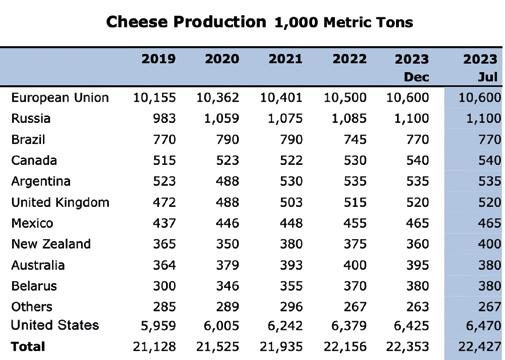
Australia cheese exports are revised down to 120.0 million tons, reflecting a weak start to the year that saw exports decline 22% through May compared to last year. Shipments to large export markets in East and Southeast Asia have been weak across the board. The industry believes that buyers have shifted to purchasing on an “as- needed basis” while global commodity prices have been high. Shipments are expected to moderately improve in the second half of the year as economic conditions improve in some of Australia’s larger markets (especially China) but import demand across other East and Southeast Asian markets is forecast to remain weak through the end of 2023.
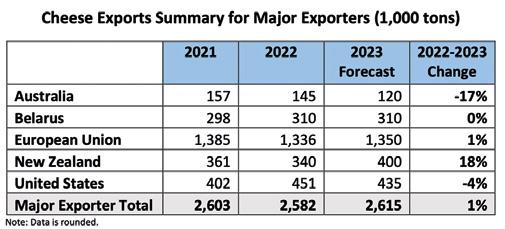
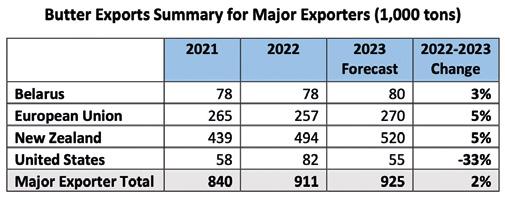
BUTTER
Butter production in New Zealand is forecast to increase to 530,000 tons, in part reflecting better returns for manufacturing skimmed milk powder (SMP) shifting larger allocations of the milk pool to butter and SMP. Exports are forecast to increase 5%, reflecting price competitiveness against major exporters of butter, notably the European Union. Through May, exports are up 11% over year-ago levels, with strong growth to Mexico (more than doubled), Australia (+80%), Saudi Arabia (+49%), and the United States (more than tripled). Growth in these markets more than offsets weaker shipments to China (-4%).
Butter imports by China are forecast to reach 135,000 tons, a decline from last year as sustained high import prices weigh on demand from bakeries, Exports were flat to start the year, reflecting weaker global demand for commodity cheeses, particularly in the United States and Japan. While tighter milk supplies and higher prices, may negatively impact the competitiveness of commodity cheeses, specialty cheeses remain popular and expected to support growing exports. Through May, shipments to the United Kingdom (+3%) are more than offset by weaker shipments to the United States (-9%) and Japan (-12%).
12 italian food & packaging technology - civ (2023) - september product trends
the food processing sector, and retail consumers. Despite heavy investment in dairy production in country, imports account for 55% of butter consumption.
SKIM MILK POWDER
Australia exports of SMP are forecast to decline 16% due to the combination of lower production and lower beginning stocks. Exports through May have slowed significantly compared to the same period in 2022. During January-May, overall exports fell by 21,000 tons (29%), led by slower shipments to Indonesia (down 8,500 MT or -53%), Vietnam (down 5,000 MT or -89%) and Malaysia (down 3,200 MT or -86%). Shipments to China have been strong this year, up 4,500 tons (+15%), and continue to account for half of Australia SMP exports as Chinese import demand for SMP has grown in response to lower global SMP prices.
European Union SMP production is forecast down 1% from 2022 reflecting tighter milk supplies. However, global demand for EU SMP has been strong through May, as attractive prices have supported EU competitiveness on the global market. Shipments have grown in each of the top seven markets, primarily in Africa, Middle East, and Southeast Asia. Exports to the two largest markets historically, China and Algeria, have more than doubled.
Although United States SMP is being competitively priced on the global market, exports are forecast to decline 1% from 2022 to 823,000 tons. Contributing to the lower SMP export forecast is slow exports to Southeast Asia, which has been an important market for growing SMP exports, as food inflation and regulatory issues in those countries impact demand for dairy products. Through May, exports have been 2% below 2022 in the same period, with shipments to the Philippines (-43%), Indonesia (-16%), Vietnam (-41%), Malaysia (-52%) and China (-39%) all significantly off last year’s pace. Growth in exports to Mexico (+43%), the largest export market for U.S. SMP exports, offsets the decline in Asian demand, as improving economic conditions drive consumer discretionary spending and higher processor demand for
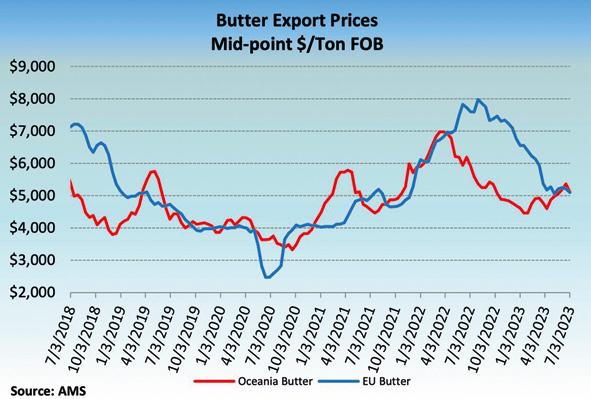
raw materials for processed
dairy products.
WHOLE MILK POWDER
New Zealand WMP production is forecast at 1.45 million tons in 2023, a 4-percent increase from 2022, but still below the five-year average. Higher returns
for whey, protein concentrates and SMP have seen processors shift milk production away from WMP. That said, WMP production still accounts for more than half of all milk processed for factory use on a milk-equivalent basis and remains the top exported dairy product on a value basis. Through May, exports are 7% higher than 2022 with strong demand from Algeria (shipments have more than doubled) and the United Arab Emirates (+33%). Continued demand from these markets will support year-over- year gains while exports to China and Indonesia moderate.
WMP production in China is forecast to increase to nearly 1.2 million tons due to strong growth in domestic milk production. Milk supplies have outpaced processing demand, prompting local governments in major dairy production regions to allocate funds to subsidize whole milk powder production. Given small capacity for butter and cheese production and high domestic demand for milk powders due to longer shelf life, dairy companies generally purchase raw milk and process it into milk powder for storage in accordance with the “Fresh Milk Purchase and Sales Contract.” Rising domestic WMP production, combined with continued high import prices, has driven a significant decline (-34%) in imports of WMP year-over-year, exacerbated by the General Administration of Customs of the Peoples Republic of China announcing that New Zealand, traditionally the dominant supplier of WMP, was poised to exhaust its preferential quota for 2023 and that safeguard measures would be implemented as built into the free trade agreement between both nations. Imports from New Zealand are down 45% through June.
www.usda.gov
italian food & packaging technology - civ (2023) - september 13 product trends
FOOD PROCESSING
High quality stainless steel filters and pumps
Bruno Wolhfarth, leader in filtration and food transfer technologies, for almost 60 years has been designing and producing stainless steel filters and pumps in its factory on the outskirts of Milan. The quality of the materials and the duration of the equipment are the two points that Bruno Wolhfarth has always considered essential and on which it has built its success.
Within the production process, the electric pump is the least complex and conspicuous element – it actually represents the core, pumping the product that is to be transformed, into the system, or collecting the finished product to be sent to the packaging machines.
System builders and end users are aware of the importance of the pump within the process and fear
the possibility of having to stop the system due to a pump malfunction, while waiting for a spare part or the repairs to be completed by the maintenance technician.
The strength of Wolhfarth electric pumps is the simplicity of disassembly and maintenance: the pump can be easily disassembled and reassembled, even by unskilled personnel.
Furthermore, the pump body machining from the solid bars of stainless steel, with no melting or welding processes guarantees the durability and the finish of the surfaces, in compliance with the most stringent standards in the food and pharmaceutical sectors.
The flexible elastomer impeller allows a strong intake and the more powerful models can gently handle creamy products, such as yoghurt or even very dense products, such as honey and jam.
An ATEX execution is possible for uses in areas at risk of explosion and the materials of the impeller and gaskets are suitable for use in contact with food, in accordance with current regulations.

14 italian food & packaging technology - civ (2023) - september
Bruno Wolhfarth is looking forward to participating in the new edition of Cibus Tec 2023 in Parma -Italy, after the pandemic-related hiatus.
The company will display filter and pump models that have been used for decades in the most im-
duction and washing cycle (clean in place). The possible connection of a Venturi vacuum generator to the solenoid valve facilitates both emptying and fast filling of the pump in the initial phase of work, even with very dense and viscous products.
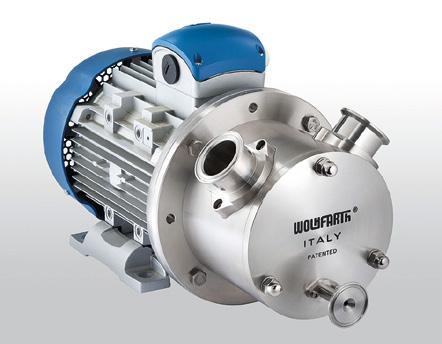
Given its commitment, even in the challenging years of the pandemic, to offer technologically
Dosing solutions
advanced products, the company is confident that its long-standing and potential customers also have the drive to start over by appreciating machines that can improve and optimise their production process.
(Bruno Wolhfarth - Via Cavour 31 - 26858 Sordio - LO - Italy - Tel. +39 02 9810153 - email: info@ wolhfarth.it - www.wolhfarth.eu)
portant industries in the sector, naturally updated to take account of new user requirements, new applications made possible by advances in electronics, and always in compliance with the latest hygiene and safety regulations.
At the Wolhfarth stand, the electric pump with on-board electronic inverter can be seen in operation as it transfers a high-viscosity gel (90,000 cps.)
This year’s new product will be the patented Hygienic Rapid Sanitary series, an evolution of the historic Rapid and Rapid Sanitaria series: the first electric pump with flexible impeller and drainage system for emptying the pump at the end of work without the need for disassembly. The application of a solenoid valve allows automatic emptying, which is particularly useful in plants where the same pump can be used in both the pro-
CEPI designs, manufactures and commissions bulk-handling systems for the storage, conveying and metering of raw materials, as well as fully integrated automation and technologies to complete all production processes. A family-run company with an international outlook, CEPI is based in Italy and operates globally, with offices in Malaysia to coordinate operations in the Asian market and a network of local partners spanning the five continents. Since 1985, it has worked with the most important companies from all sectors of food manufacturing.
CEPI’s vision has centered research, customization and flex-
ibility since its beginnings. The mission goes beyond assembling food machinery: it builds turnkey installations that manage the production line from storage to dosing, all the while developing specialized solutions to match diverse and ever-changing needs across the planet. CEPI brings to the table a global knowledge of materials, environments, and markets as well as the continued research that goes into developing around 300 unique systems every year.
Powders, granular products, liquids, fats. Macro, micro, medium volumes. Fermentation, cooling, fluidization, milling, blending,
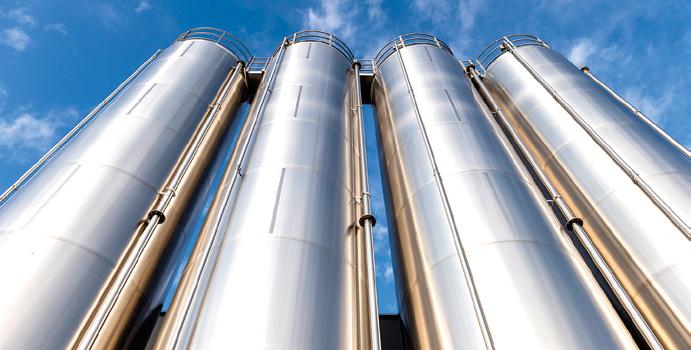
food processing italian food & packaging technology - civ (2023) - september 15
HRS series stainless steel pump (Bruno Wolhfarth).
CEPI outdoor silos.
rework. CEPI motto is: if your process needs it, we can do it. If we can’t do it yet, we will develop it, just for you. Our technologies evolve to match each individual demand from the manufacturer side, leading to unparalleled technological range.
CEPI’s offer includes multiple indoor and outdoor storing options in stainless steel or antistatic fabric, minisilos and dumping stations for medium production volumes and broad spectrum stations for the storing and accurate dosing of micro ingredients. Materials are moved by clean and efficient conveyance systems designed to minimize energetic impact. Dosing can be continuous or batch, positive, by loss of weight, by volume or by weight, in modular hoppers for powders and tanks for liquids. The 3 in 1 station weighs the ingredient, separates air from product during pneumatic transport and comes with vertical blender for the production of premix. Other applications include flour cooling, fermentation, sugar mills, invert sugar technology, salt solution systems, fat and liquid tanks, fat cold metering, bread
and biscuit rework systems including liquid rework of sandwich biscuits, and CIP washing system for a complete hygienization of tanks and pipes.

CEPI provides a turn-key system that includes fully integrated automation, with production management through touch panels and software for full traceability and warehouse management. Hardware and software design is done completely in-house. With vast food technology expertise, all the technologies are developed factoring the preservation of flavor and ingredient properties, with automation ensuring repeatability and precision of the recipe. Each system is designed through a comprehensive study manufacturer’s processes that includes all operations from warehouse to marketing, and customized to match analysis of raw materials, site evaluation, environment and consumptions.
CEPI believes in build lasting relationships for lasting projects, through an ongoing conversation which concerns all its aspects: from process and product analysis with hygiene and safety
management and food technology support, to engineering and control, manufacture, installation and service. All these stages are managed internally and with continuity through all operations and all-encompassing support, the company can give each project the care it deserves.
CEPI takes a long-term view when it design systems, in order to create the most flexibile solution for each food manufacturer, one which does not preclude any new path they may take in the future. Because this method is organic and involves all departments, it includes a projection of future productions and makes CEPI installations very easy to adapt to any new developments. One of its strengths is the ability to bring new life to installations that would otherwise be decommissioned. This activity, known as revamping, makes it possible to extend the useful life of the plants indefinitely: systems that were built 30 years ago are still functioning efficiently. The installations are circular products that fit with the circular economy model.
Having experienced continued growth through its history and after the exceptional results of the past few years, CEPI has built a new facility in 2021 that tripled productive area to a total of 15.000 m2. The new home is powered and heated by renewable energy, designed to completely safeguard worker safety, and includes a 240 m2 testing and prototyping room with metrology room as a testament to its dedication to research.
(CEPI - Via Selva 10 Z.I. La Selva - 47122 Forlì - FC - Italy - Tel. +39 0543 940514 - Fax +39 0543 940534 - email:cepi@cepisilos. com - www.cepisilos.com)
food processing 16 italian food & packaging technology - civ (2023) - september
Dosing plant (CEPI).
Food Safety is of paramount importance to protect consumers and their health. As Megadyne, we take up measures to continuously develop solutions improving the level of hygiene and safety in compliance with ISO 22000, EC 1935/2004, EU 10/2011 and FDA standards: Metal & X-Ray Timing Belts, Megafl ex FCM, Megalinear and Megapower FC (Food Contact). Contact us to make your food production safer. www.megadynegroup | info@megadynegroup.com WE



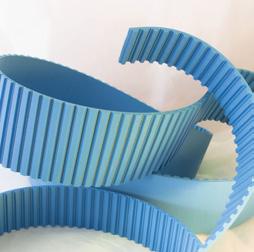

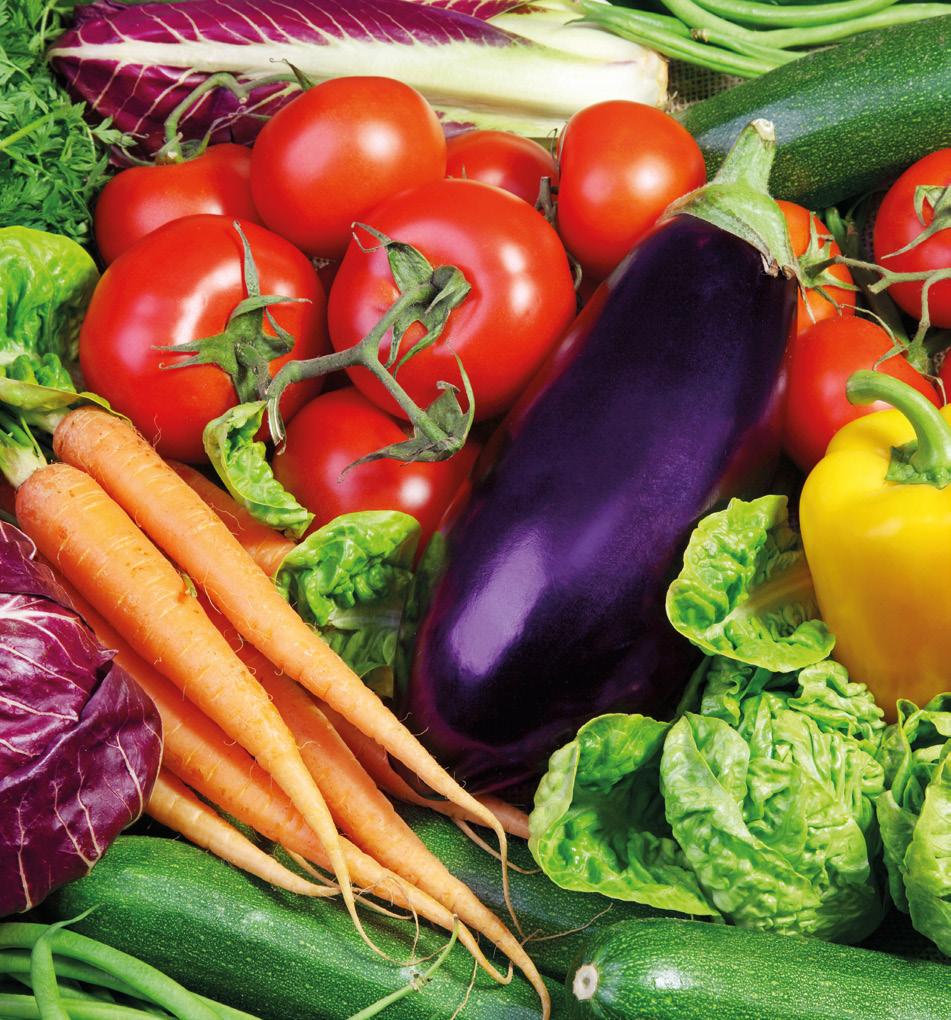
MAKE YOU BUSINESS MOVE NO COMPROMISE IN FOOD SAFETY! Member of Ammega group SUBSCRIBE
to watch the video
Scan
LM at Interpack with its “loops”
The LM Group, with LM, Marpatech and Magnoni brands showed at Interpack quality construction, high versatility and customization.
Similarly to what was shown a year ago at Ipack-Ima, the two installations have made it look two entire lines for the transport and handling, totally conceived to demonstrate the functionality and reliability of the group.
First loop showed a primary packaging transport as cases or flow-pack and itfollows a path that includes a wash down plate divider, a retractable and tilting conveyor, a modular plastic chain curve, a wash down knife edge curve and a sortech. The sortech is a new flexible sorting system highly appreciated around the world and able to meet mul-
tiple sorting, alignment and reject needs. During the transport, product is handled through the various application without being contained by side guides.
In the second line all handling possibilities for empty aluminum cans was shown. The loop has been assembled with a multilaner, an air veil conveyor (which transport and lifts cans through puffs or air jet without moving any me-
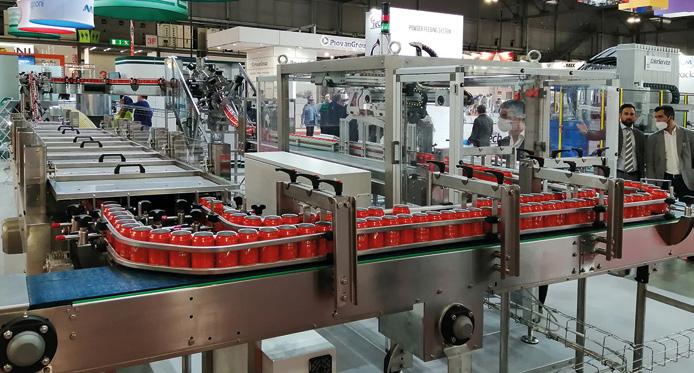
Innovation in jelly production
Agathon GmbH – world market leader and benchmark for high quality chocolate moulds – and Pinco SA – drying rooms manufacturer for jelly products – are delighted to announce a cooperation for the development of the logTEC technology for the manufacturing of jellies.
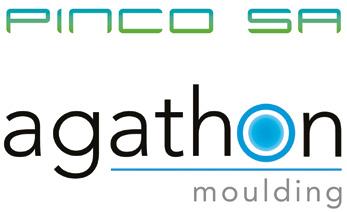
Both innovative companies enter into a partnership supporting the jelly producers’ process monitoring under industry 4.0 standards, e.g. in validation and improvement for the drying cycle.
With the Agathon’s logTEC technology and Pinco´s exper-
tise, a complete data analysis becomes an efficient toolfor all global Pinco customers: an outstanding device for the monitoring of product quality and process transparency, with the
chanical parts), a vacuum system for changing height in a limited space and at the end an automatic twister. This “loop” clearly illustrates some application that LM group, in particular Magnoni brand, can propose for the handling of this very delicate product.
(LM Group - Via delle Nazioni 95 - 41122 Modena - Italy - Tel. +39 0593164411 - Email: info@ lmgroup.it - www.lmgroup.it)
priority on energy analysisand savings.
(Pinco - Via Pra Mag, 9 - 6862 Rancate - Switzerland - Tel. +41 91 640 0800 - Email: info@pinco-sa. com - www.pinco-sa.com)
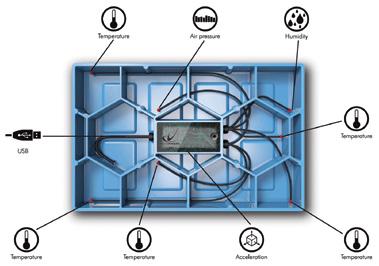
food processing 18 italian food & packaging technology - civ (2023) - september
Pinsa line by Albaequipment
For an exclusive product like Pinsa, an equally exclusive line is needed.
Pinsa Line has been studied and designed by Albaequipment to process the product as handmade to respect its origins.
The peculiarity of the Pinsa lies in being very digestible because it has less yeast and the dough is left to rest for 24 hours or more. The preparation is based on the right calibration between the mixture of flour and water, in order to give it the appearance of a soft, light and digestible cloud of bread.
The Pinsa dough therefore requires a long process, it is very hydrated and needs careful spreading which, up to now, has been obtained by the fingers of the craftsmen.
But Pinsa Line is the solution. A Line able to work with the yield of hand-made doughs with high hydration.
It is the innovation of the year and is already enjoying enormous success! This line allows you to easily work with highly hydrated dough. The rendering of the bubbles and alveolation is possible thanks to special tools that it was developed after a careful study of the natural movement
of the hands in the dough. You can choose whether you want to automate the entire process or just part of it.
The spreading takes place by working the pinsa with irregularities just like artisanal products.
The production respects the structure of the dough prepared with attention and care. It is possible to insert additional components such as tomato dispensers and spreaders or cheese distributors.
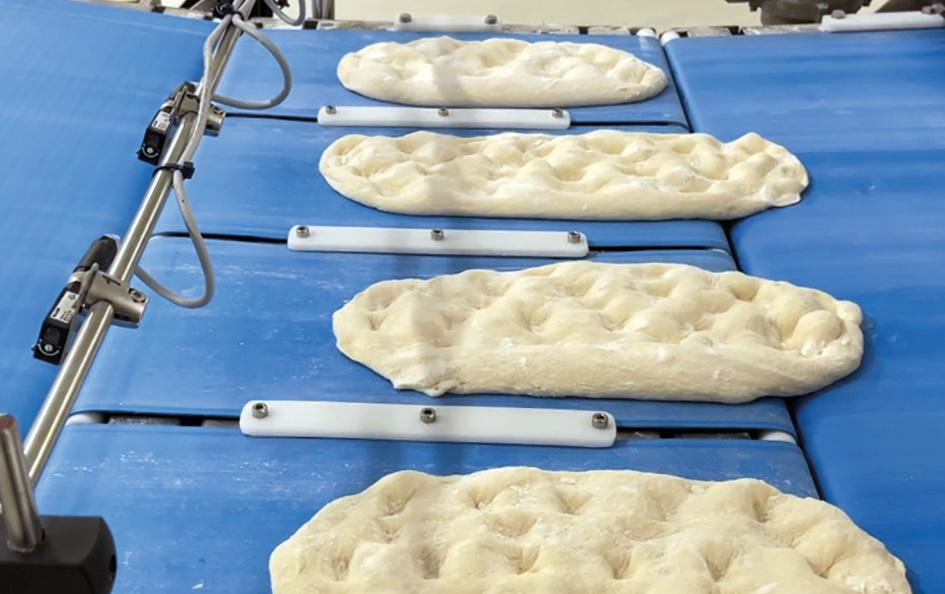

Still not convinced? Come and test your dough in Albaequipment laboratory and what you have read will come to life before your eyes. An artisanal rendering with industrial production!
(Alba & Teknoservice - Via delle Industrie 26 - 35010 Villafranca Padovana - PDItaly - Tel. +39 049 9070380Fax +39 049 9074042 - email: sales@albaequipment.it - www. albaequipment.it)
food processing italian food & packaging technology - civ (2023) - september 19
Megadyne food safety solution
For Megadyne , a global leader in the Power Transmission field and member of AMMEGA Group, food safety is of the utmost importance for the health of all consumers and viability of businesses dealing with food.
The company has therefore broadened the MEGALINEAR FC (Food Contact) range of belts by introducing new profile options to increase application possibilities in food processing.
Designed specifically for food processing and packaging industries, MEGALINEAR FC is manufactured from materials approved for food contact; according to FDA and European EU 1935/2004, EU 10/2011, EU 174/2015; it’s pro-
duced with T5/T10 pitch without gaps between the teeth to avoid food contamination.
This advanced range of FDA synchronous belts meets the criteria where food contact is required, ensuring maximum reliability and total hygiene without compromising performance.
Indeed, MEGALINEAR FC, matches the power and precision for synchronous conveying (balanced tracking, low running tension, and low vibration) and guarantees excellent resistance to chemicals and corrosion, making it the perfect choice for both wet and dry food contact processing.
MEGALINEAR FC is now available in a wider variety of back-
ing profiles, for all kinds of food processing and packaging applications: Smooth, Longitudinal Ribbed, Transversal Ribbed, Noppen Oval, Roof, Spike Small, Spike Large, Truncated Pyramid, Truncated Cone, Lamella.

In addition, the smooth FC, gap-free belt with T5 and T10 pitch can be further customized with cleats according to your specific need. Contact the experts to learn more about MEGALINEAR FC! By working together, Megadyne can increase your capabilities, implement best-in-class food safety practices, and help you secure and improve your food safety conveying performances.
Food Safety First: Megadyne Binding Promise
Since founded in 1957 in Mathi (Italy), Megadyne has grown to become a Global Leader with a manufacturing and sales presence throughout Europe, Asia and the Americas.
Clean, safe and resistant to oil and grease, their food belts are suitable for contact with all kinds of food products and designed for all food industry processes: from bakery to fruit and vegetables, from confectionaries (including chocolate and candies) to seafood and fish.
(Ammega Italia - Via S. Lucia 114 - 10075 Mathi - TO - ItalyTel +39 011 9268052 - Fax +39 011 9241746 - email: info@ megadynegroup.com - info@ammeraalbeltech.it - www.ammega. com)
food processing 20 italian food & packaging technology - civ (2023) - september
MEGALINEAR FC, the Megadyne food safety solution.
GRINDING MILLS AND PLANTS
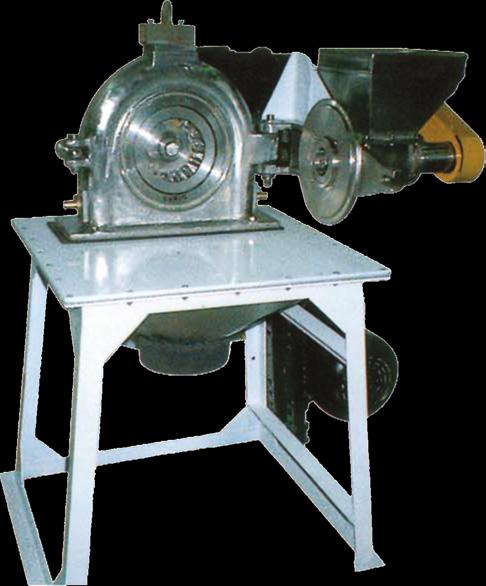
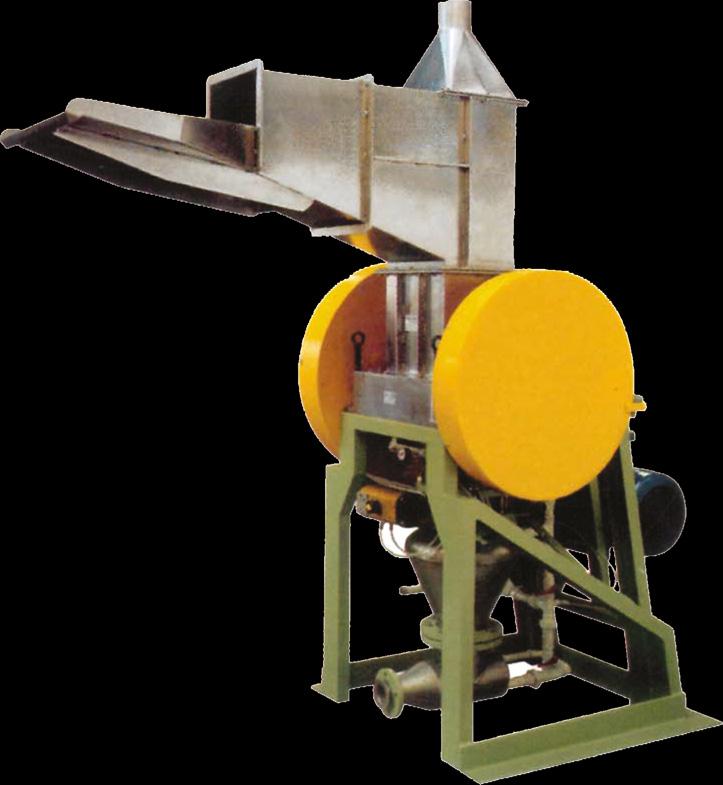
ITALO DANIONI manufactures grinding mills, mixers and crushers since 1918. The Company also produces closed circuit, refrigerated and conditioned and explosion proof plants for products in powder Customers have at their disposal a test room with industrial machines for verification of functioning and capacity





Upgrading to existing installations

Via Mecenate, 78/b 20138 Milano - ITALY Tel. +39 02 504095 +39 02 504195 Fax +39 02 5062646 info@danioni.com w w w . d a n i o n i . i t
Being refined is simple
In the field of chocolate and fat cream processing, innovation is a key factor in improving efficiency, reducing space requirements and achieving significant energy savings.
With this in mind, the P10S continuous grinding and refining plant by Tecno 3 proves to be a revolutionary solution.
In addition to simplifying the production process, this compact and precise plant offers extraordinary advantages in achieving optimum fineness for different types of chocolate and fat creams.
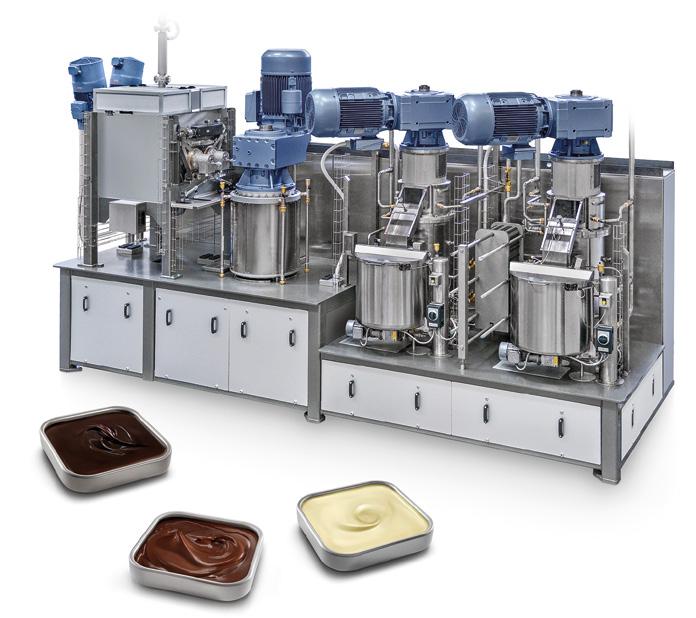
Everything goes in the same direction: simplification
The P10S combines grinding and refining in a single step. This represents a major step forward in process simplification, saving precious time and optimising production efficiency. In addition,
the plant reduces the size due to its compact design, offering a versatile solution for limited work space.
Advanced three-stage
technology
The first stage includes a pre-refiner with two horizontal cylinders, followed by a refiner with vertical cylinders in the second stage. The third stage involves the use of a ball refiner to achieve optimal particle size reduction. This combination of grinding units enables consistent, high-precision refining results.
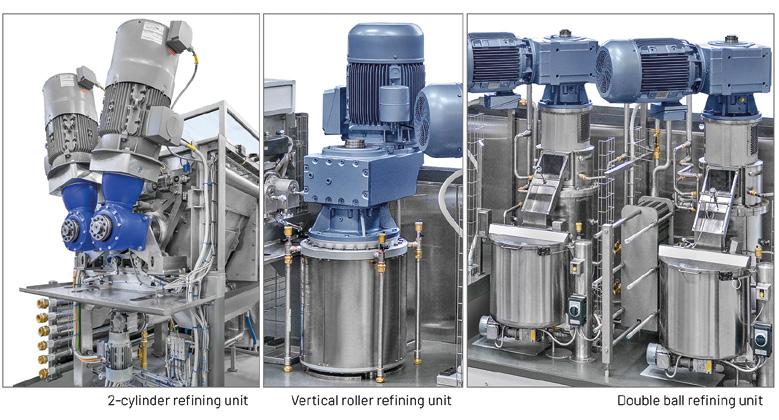
Intelligent process control
Grinding in the ball plant is managed by an advanced electronic logic that considers several critical parameters. The flow rate of product to be refined, rotor speed, working temperature and internal pressure of the refining chamber are carefully monitored
food processing 22 italian food & packaging technology - civ (2023) - september
The P10S plant strives for ever more efficient solutions (Tecno 3).
to ensure ideal particle size distribution. By avoiding the excessive formation of too fine particles (surfins), the resulting chocolate and fat creams have optimal rheological characteristics for the subsequent processing steps.
Preserving product characteristics
A key aspect of the P10S plant is its ability to preserve the organoleptic characteris-
tics of the product. Thanks to the process developed continuously, without contact of the product with the outside world, it is possible to keep the sensorial and taste properties intact. Furthermore, the careful management of temperatures during the milling and refining stages helps to preserve the quality of the final result.
At a time when efficiency and optimisation are crucial to progress, the P10S plant stands
out as a state-of-the-art solution that takes simplification to a next level.
A significant breakthrough for the industry that offers to companies the opportunity to increase their competitiveness and improve profitability.
(Tecno 3 - Via Mastri Cestai 2 - 12040 Corneliano d’Alba - CN - Italy - Tel. +39 0173 610564 - Fax +39 0173 619494e-mail: a.mattis@tecno-3.itwww.tecno-3.it )
Two-stage process for energy valorization of cheese whey

An Italian work published in Fermentation journal investigates a two-stage process scheme for cheese whey valorization through energy recovery in different forms by means of bio-electrochemical systems.
The first stage consisted of an integrated bio-electrochemical process for H2 and electricity production. This combined dark fermentation with an electrochemical system with the aim of overcoming the typical thermodynamic/biochemical limitations of fermentation and enhancing H2 recovery. The second treatment stage involved a single-chamber microbial fuel cell, featuring an innovative configuration consisting of four air cathodes with fly ash as the oxygen reduction catalyst.
The bio-electrochemical process performed in the first stage achieved promising results, displaying a three-times higher H2 production yield compared to
conventional dark fermentation. In addition, the experiments using the MFC in the second stage were found to successfully exploit the effluent from the first
stage, with COD removal yields of 86% ±8% and energy recovery with a maximum current output of 1.6 mA and a maximum power density of 1.2 W/m3
food processing italian food & packaging technology - civ (2023) - september 23
Decarbonizing process heat in the food and beverages industry
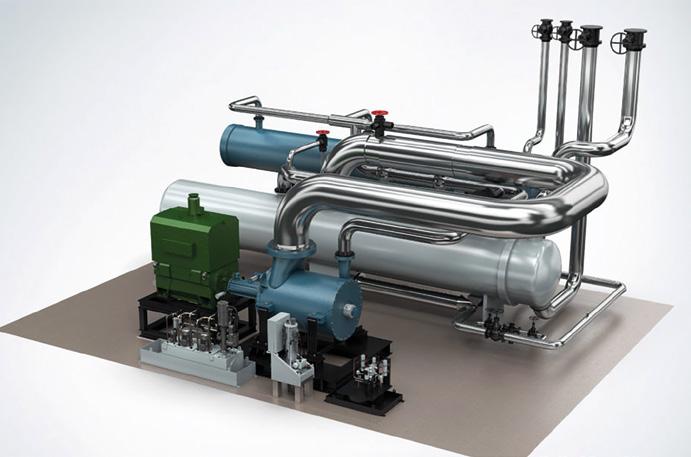
High-temperature heat pumps (HTHPs) are an emerging technology to improve overall process efficiency and reduce energy demand while enabling a switch from fossil fuels to renewable electricity. New industrial HTHP technologies aim to achieve an output heat temperature of 250°C, suitable for decarbonising the food and beverages industry considering its temperature requirements of <250°C.
Researchers from Nederland employ a bottom-up approach to investigate the techno-economic feasibility of integrating new HTHP technologies into heat processes of the German food and beverages industry and estimate emissions reduction potentials under waste heat scenarios.
The results published in Resources, Conservation & Recycling journal indicate that the new HTHP technologies
could meet 12 TWh of process heat demand in the German food and beverages industry and cut emissions by 9% considering Germany’s current electricity fuel
mix. A modest carbon tax of 38 E/t CO2 eq. or higher makes the HTHPs cost-competitive with an optimised fossil fuel-based alternative.
Impact of different processing techniques on the black truffle
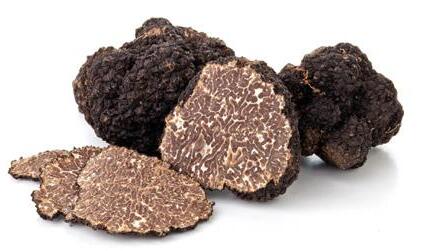
Fresh truffles which include black truffle (Tuber melanosporum Vittadini) deteriorate and lose aroma rapidly after harvest; therefore, postharvest processing via freeze-drying or encapsulation is an option to preserve truffle aroma for extended supply. However, the aroma profile that directly affects the truffle quality and consumer acceptance is influenced by processing and producers require processing options that balance process-
ing feasibility with retention of a suitable aroma profile.
A study carried out by Australian Researchers aimed to determine the impact of freeze-drying and encapsulation on the profile of key volatiles, consumer discrimination, and overall sensory impression (aroma intensity, liking, and acceptability) of processed truffle products compared to the starting material (positive control). The study, published in the Journal of Food Science, combined experimental-scale processing with GCMS analysis and consumer sensory evaluation to compare and optimize postharvest processing options. Based on the results, some volatile changes were detected in the processed truffle products compared to the positive control which were aligned with the consumer discrimination (triangle
food processing 24 italian food & packaging technology - civ (2023) - september
test) and the aroma intensity score (consumer sensory test). Despite some chemical and sensory differences detected, the consumer panel did not have any preference for processed truffle products compared to the positive control. The overall finding indicates the potential value of processing truffles into a natural flavoring ingredient for food application via freeze-drying or encapsulation, which should be of great interest for the truffle and food industry. According to the correlation analysis, the consumer acceptance of a truffle product may be increased by retaining 1-octen-3-ol
and methional, while reducing the amount of p-cresol in the product.
The postharvest process of turning truffles into a food flavoring ingredient may cause undesirable volatile changes that would directly impact the aroma quality and consumer acceptance of the processed truffle products. Hence, the impacts of freeze-drying and encapsulation on the chemical and sensory profile of truffles were evaluated in this study. Overall, the results of the concurrent instrument and sensory analysis demonstrated that both freeze-drying and encapsulation are potential options for processing.
Estimation of harvested fruit weight with distance sensors
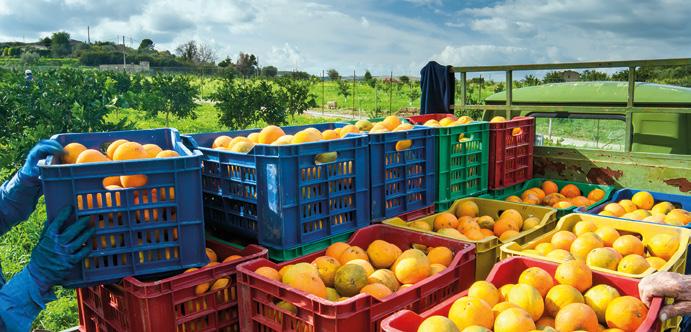
The introduction of fruit tree harvesters on the market allows the opportunity to incorporate new yield monitors. Traditionally, yield has been measured by inthe-field fruit batch weighing systems that employ load cells, which present certain problems as well as oscillations and outliers.
Spanish Researchers propose the development and evaluation of two distance measurement systems (an experimental one using an array of sensors with lowcost, Time-of-Flight technology and another, commercial system, with a 3D camera) to estimate the volume of fruit harvested in a big box and correlate the volume with its weight. To this end, two algorithms were developed to estimate the volume of fruit filling. Several tests were conducted to determine the field of view of the sensors and the influence of illumination, reflectivity of different
surfaces, and vibrations in transit on the measurements they give. Illumination was a limiting factor on the accuracy of the experimental system and required mitigating actions to operate with it. The mean relative error of sensor distance measurement was less than 0.8% and 1.6% for the commercial and experimental systems, respectively, which decreased as distance from the measurement
target increased. Measurements on matte surfaces showed a lower measurement error than those on glossy surfaces, with error being twice as high in the commercial system than in the experimental system. The error in volume estimation was lower in the commercial system and could be reduced to less than 1.6% with pre-calibration. In general, with the accelerations typical of agricultural traffic, in dynamic operation the distance sensors provided less variation in results than the load cells, which would require processing of the recorded signals. In the range of filling a box over 150 kg, the absolute error in weight estimation was 5.4kg for the experimental system and 11.0 kg for the commercial system. However, this error may increase with the use of the experimental system if filling occurs from the center or from the corner.
In general, the systems offer acceptable results for using this technology if extreme accuracy is not required. This work, published in Computers and Electronics in Agriculture journal, establishes the basics of a technology that can be an alternative to load cells and be applied to harvesting machinery to record continuous real-time production.
food processing italian food & packaging technology - civ (2023) - september 25
Infrared and microwave alternate thawing method for frozen pork
The effect of infrared and microwave alternate thawing (IR + MWT) on frozen pork were compared to fresh, air thawing (AT), infrared thawing (IRT), microwave thawing (MWT). The results of this Chinese research were published in Meat Science journal,
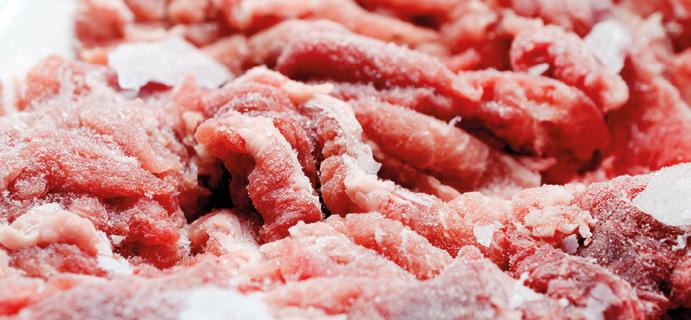
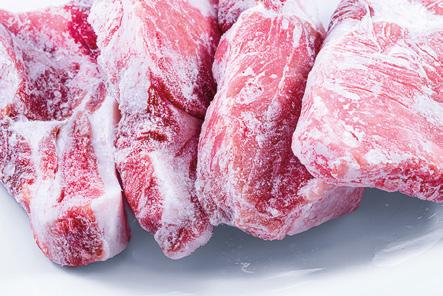
The IR + MWT took only about 11.81 min of the thawing time compared to AT 66.5 min, and the Raman spectroscopy and Lowfield nuclear magnetic resonance (LF-NMR) results showed that the IR + MWT maintained better protein secondary structure compo-
sition and moisture state compared to MWT and IRT. In terms of thawing losses, IR + MWT had the lowest loss 1.92%. In terms of texture, IR + MWT had the least effect on the post-thawing textural properties and increased the springiness of the meat. Scanning electron microscopy results also showed that there was reduced damage to the muscle structure with IR + MWT. Regarding the odor of the meat after thawing, IR + MWT retained the odor better and was closer to the fresh sample.
Therefore, IR + MWT can be used to enhance the thawing rate to protect the quality of the thawed pork.
Influence of low-pressure tumbling on the quality characteristics of thawed pork
Maintaining the water holding capacity (WHC) and minimizing the drip loss during the thawing of frozen meat are of utmost importance. With this aim, a Korean study published in the Korean Journal of Food Preservation investigated the physicochemical properties of frozen pork sub-
jected to thawing under different conditions: at room temperature (20°C, under air), at a low temperature (4°C refrigerator, under air), under water (20°C, under water in a vacuum bag), under microwave (microwave-thawing, 260 W), and under low-pressure tumbling (20°C, 0.015 bar, tumbling).
The shortest thawing time for frozen pork was recorded upon low-pressure tumbling thus indicating a fast heat transfer. The lowest drip loss (0.2%) and highest WHC (94.5%) were also recorded under this condition. A significantly higher drip loss was observed upon microwave-(1.0%) and water-thawing (1.2%), which resulted in the lowest WHC in microwave thawing (87.2%). The highest total count of aerobic bacteria and coliform group were observed upon room temp thawing while the low pressure tumbling and thawing resulted in the lowest aerobic bacteria (1.90 log CFU/g) and coliform (0.78 log CFU/g) count. Consequently, thawing by low pressure tumbling afforded the best food quality.
food processing 26 italian food & packaging technology - civ (2023) - september
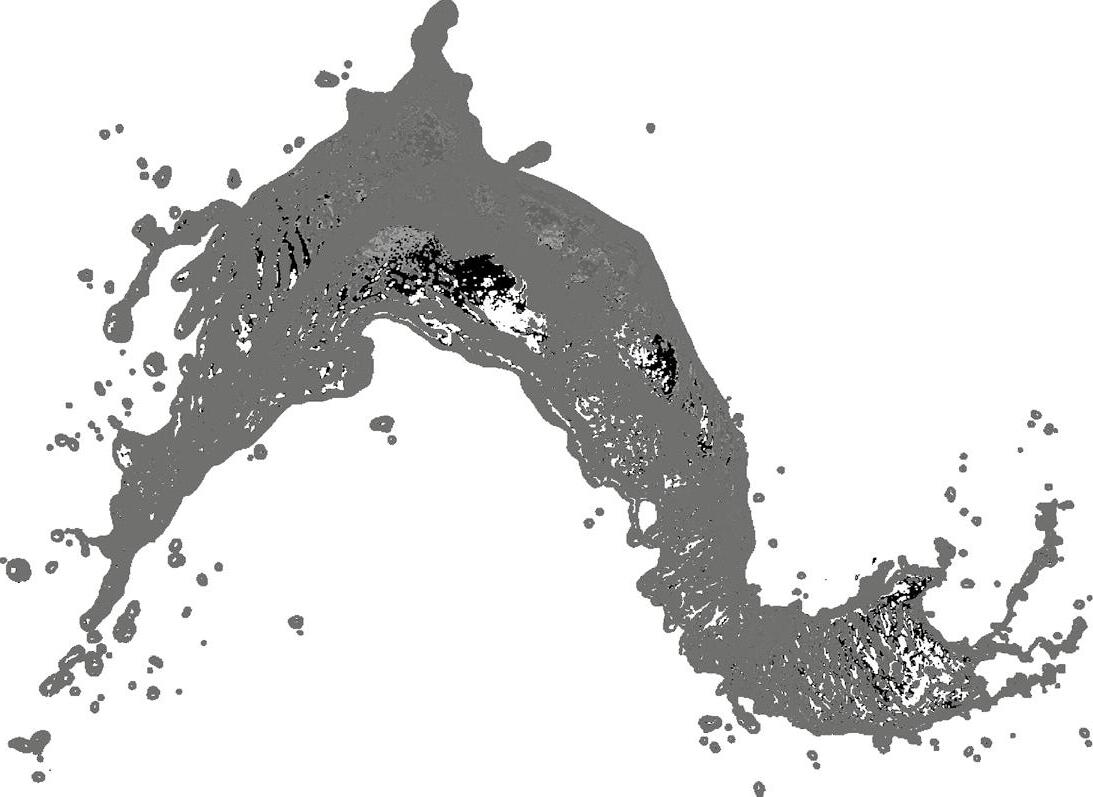
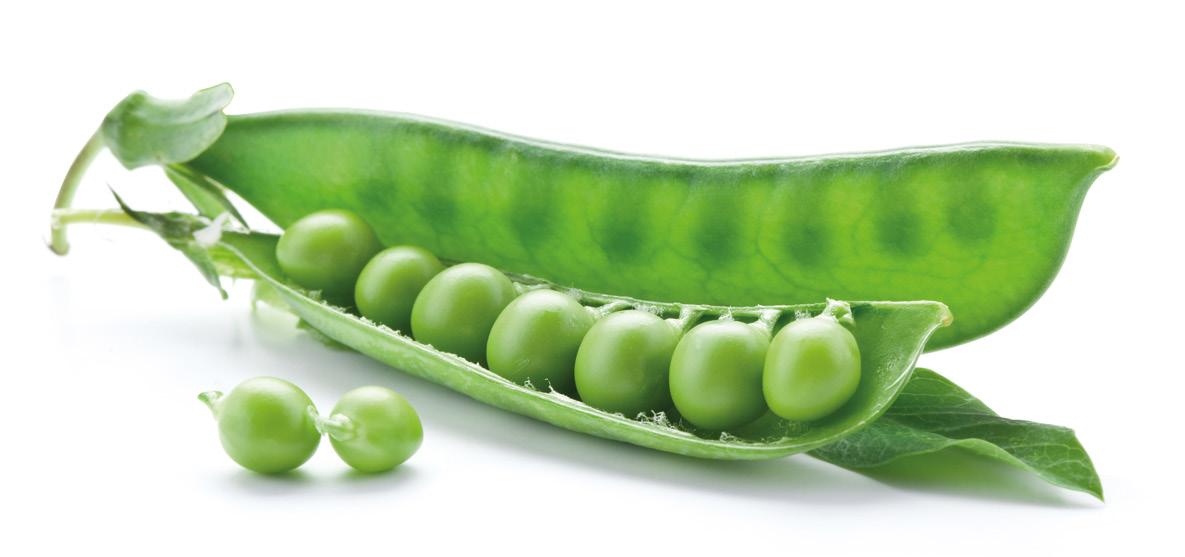

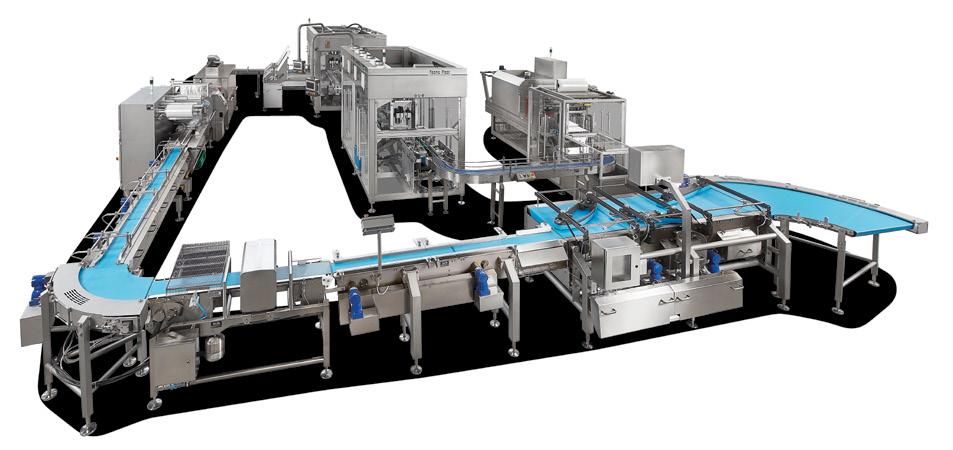
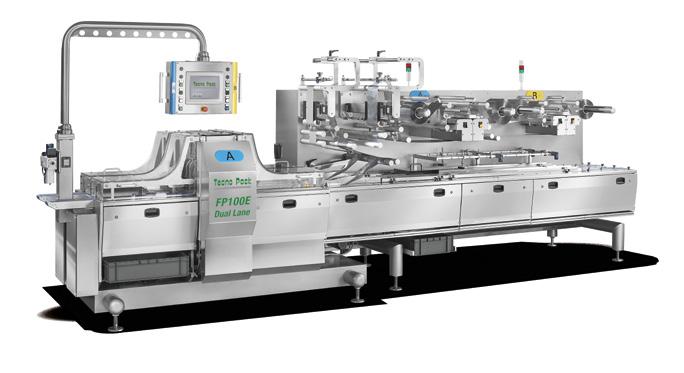
Baked goods: Automated packaging for sensitive goods

Baked goods are popular, which lends them their enormous variety worldwide. Whether from the supermarket shelf or as frozen delivery – bread, bread rolls, croissants, pastries and cakes are sensitive foodstuffs that place high demands on production processes and packaging. Therefore, automation and digitalisation are also becoming increasingly important issues for the bakery industry. And the issue of sustainability has long since arrived in the sector.
Without any form of packaging, bread, bread rolls etc., are usually only available in a bakery. Freshly bought products should however also be promptly consumed. By contrast, industrially produced baked goods cannot do without packaging. Soft croissants or cakes, for example, are very sensitive to pressure, biscuits are often fragile. Robust trays are needed, while other baked goods can be safely packed inside tube bags. But packaging not only protects against mechanical hazards: Certain barrier properties allow packaging to extend shelf life without compromising on high quality. Growing mobility, an increase in single households and increasing consumption outside the home make reusable packaging for use to-go or smaller packaging sizes very attractive. Sustainable packaging materials must meet all these requirements as well, which are increasingly in demand by the market – a real challenge for the producers of baked goods and packaging. But recyclability, reduced usage of material and less packaging have long become trends within the baked goods sector, and
28 italian food & packaging technology - civ (2023) - september PACKAGING
TRENDS
Baked goods are sensitive products that need safe packaging. Image: GHM.
so, monomaterial film, paper-based solutions and cardboard packaging with biobased coatings have already become industry staples.
Europe dominates the consumption of baked goods
Statista has determined the turnovers for the production of baked goods within the European Union: According to the results, Germany with a turnover of 22.7 billion euros and France with 21.5 billion euros are at the top, followed by Italy (6.7 billion euros), Spain (5.8 billion euros) and Poland (4.7 billion euros). On the global market for baked goods, according to Mordor Intelligence, Europe generates the largest share of turnover. According to the market researchers’ infor-
mation, the developed markets in Western Europe are mature and saturated when it comes to baked goods, while the developing countries in Eastern Europe drive sales of biscuits and bread due to their high demand for convenience food products. The European baked goods market is said to be well established in terms of the supply chain, the product range, the sales channels and the preferences of consumers.

Automated solutions for the bakery industry
Things are not easy right now for the baked goods industry: High cost pressure, increasing variety of products, a change in consumers’ habits and the demand for more sustainability result in new requirements towards both production and packaging processes. In order to remain competitive, manufacturers of baked goods need flexible systems with which to react to market trends. In the future, it will be almost impossible to avoid a higher degree of automation. Digital processing and packaging machines are therefore of great importance, as is the growing integration of robots. These automated assistants have become an integrated part of the bakery industry as well. Pick-and-place robots, equipped with suitable gripping tools, are even packaging sensitive products like biscuits, bars or other baked goods. If the product or format changes on the packaging line, only the associated gripping tool needs to be changed. Long downtimes are avoided this way. For example, Syntegon has developed a proprietary Intelligent Direct Handling (IDH) pick-and-place system for cookies, crackers and biscuits, which uses linear motor technology for an especially gentle handling of the sensitive products. The system also enables faster production speeds, as it can grip several products at the same time and place them on feeding belts or into trays in a single work step.
Packaging machine manufacturer R. Weiss
Packaging offers complete packaging systems for the bakery industry, which are based on a modular system. This system uses standard modules for all packaging processes, like righting, top loading, closing, marking and palletising. The picker lines consist of several cells in a row, which, depending on the requirements, are equipped with several delta pickers mounted one after the other. They are designed for sorting and packaging unpacked products and products in primary packaging. Products pre-grouped in a line or fed chaotically are recognised by a camera system and fed into the top loading area through a transport system.
packaging trends italian food & packaging technology - civ (2023) - september 29
Robots are also used in final packaging: A strudel dough manufacturer from Vienna, for example, uses two Stäubli robots to meet the increasing demand. Among the special properties of the line are the hanging arrangement of the two robots as well as the absence of a safety guard. The Swiss manufacturer’s robots package strudel dough for the food industry in a 1.5-second-rhythm: four packages wrapped in foil, each containing two sheets weighing 125 grams each, are packed inside a box. One robot grips the units wrapped in foil, while the other prepares the box.

Cobots are fast learners
Collaborative robots, also known as cobots, make production even faster and more flexible. Packaging machine manufacturer Gerhard Schubert uses cobots in their machine concepts for fast feeding of different products. The new Schubert cobots tog.519 are ready for serialised production and are optimally
suited for retrieving light-weight products via pickand-place from a disordered feed and processing them with a frequency of 90 cycles per minute. The AI-supported programming and image processing has been designed in such a way that customers can easily carry out a format change without any necessary programming and in a very short time. In principle, the only thing that needs to be done is to hold the new product up in front of the cobot. According to the manufacturer, the advantages of this cobot solution are flexible application sites, a large variety of pick-and-place tasks, a high processing speed and its very simple operation.
Using different recyclable types of wrap on one system
Depending on their consistency and ingredients, baked goods need packaging with different barrier properties. If products change frequently, manufacturers often have to quickly change between tube wraps with different properties. To solve this problem, Schubert offers a flow packer with matching sealing technology in their portfolio. This makes it possible to use both recyclable mono-plastic wraps and paper-based tube wraps on the same machine.
Interpack exhibitor Multivac, too, is able to fall back on their experience from a wide range of different projects for the bakery industry. These include handling very different products, for example, toasties, bread or pancakes – and individually designed line concepts to match. For example, the company has developed a full wrap labelling solution for foldable plastic trays. Pressure-sensitive baked goods like cookies, muffins, donuts, pieces of pie or entire
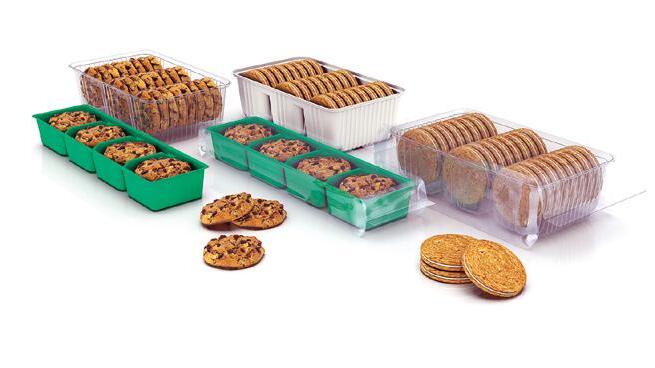
packaging trends 30 italian food & packaging technology - civ (2023) - september
A newly developed picker technology based on linear motors guarantees an especially gentle handling due to even movement.
Image: Syntegon Technology.
The Syntegon IDH pick-and-place solution offers a high grade of flexibility for both products and packaging style.
Image: Syntegon Technology
cakes are often packaged in such transparent foldable trays, which are then usually wrapped with a cardboard package band. The conveyor belt labeller by Multivac is said to save up to 70 percent of material compared to labelling with a cardboard package band. The model features servo-driven pressure brushes, which allow for C- and D-labelling of up to 120 packages per minute at a label width of up to 500 millimetres. Other than as a simple top label, a label can be placed in a C-shape over three sides or in a D-shape over all four sides of the packaging. Both the C- and D-labels have the advantage of sealing the package at the same time according to the manufacturer. With the new full wrap labelling solution, Multivac has expanded their portfolio for the baking trade and the bakery industry.

Producing baked goods at high speed
Many systems in the bakery industry work at very high speeds, but at the same time, there is an expectation of constant high quality. Mixing and kneading systems for constant operation, like those of interpack exhibitor Zeppelin, are the tools needed for the job and can produce 20,000 pretzels per hour, two million bread rolls a day or three tons of biscuit dough per hour. Before packaging, many baked goods must be precisely cut to size. Döinghaus offers individual solutions for cutting that utilise ultrasound, among them the universal cutter Ultracut Nado, which cuts both round and angular products. The size of individual piec-
This flow packer with flexible lateral sealing can process different recyclable wraps on the same system.
Image: Gerhard Schubert GmbH.
es and segments, as well as different cutting speeds, are freely selectable using a touch panel with intuitive operation.
And igus GmbH from Cologne, manufacturer of plastic bearings made entirely of plastic as well contributes to seamless operations in the production of baked goods. A greaseless linear system, for example, is being used in an industrial wafer baking system made by specialised mechanical engineering company Walterwerk. The system bakes standardised wafers for the industrial production of ice cream, which are fed into a rolling station and rolled up while still warm. Afterwards, they are transported to the cooling tower over a conveyor belt, before the wafer is given a paper cone in the confection area. In this area, the linear bearings made of tribo-optimised high-performance polymers by igus are used during separating and feeding.
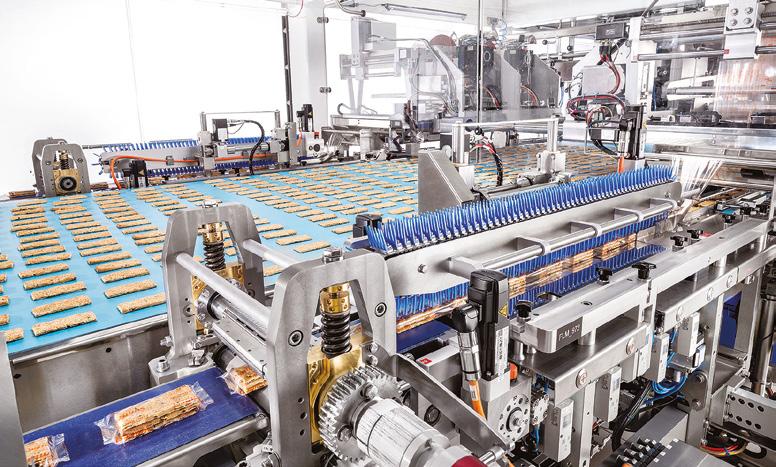
www.interpack.com
A full wrap solution reduces the materials used when labelling foldable trays.
Image: Multivac.
packaging trends italian food & packaging technology - civ (2023) - september 31
The european market for carton board
During the pandemic, online retail virtually exploded – but now the development of e-commerce is slowing down again. Nonetheless, manufacturers and suppliers of shipping packaging can continue to expect growth, even if it is no longer as strong as in the previous record years of 2020 and 2021.

In their new market study on corrugated board, solid board and cartonboard packaging, the analysts at Ceresana forecast that demand in Europe for these materials will increase by an average rate of 1.8% per year until 2032. Individual branches of the economy are suffering from the poor consumer confidence, such as paper goods, stationery, office and household supplies, cleaning and laundry. Conversely, demand for packaging is growing, particularly for e-commerce, electrical and electronics, pharmaceuticals and medicine but also for chilled and frozen food.
Sustainable Corrugated Board for the Circular Economy
Corrugated board is a true closed-loop product made from renewable raw materials and is mainly manufactured from waste paper and used cartonboard; the pulp for virgin fibers usually does not come from trees cut down specifically for this purpose but from scrap and thinned wood. The smooth and corrugated paper webs are glued together with glue made from plant starch. Stable packaging made of corrugated board offers very good product protection and stackability at low weight. They can usually be reused and recycled several times; in some cases, they are compostable after use. In many cases, corrugated board is therefore a more environmentally
packaging trends 32 italian food & packaging technology - civ (2023) - september
friendly alternative to plastic packaging. The current market study by Ceresana examines the demand for corrugated board packaging for 10 individual application areas, such as food, beverages, fashion, furniture and chemical products.
Combining Cardboard and Plastic for Effective Advertising
Despite environmental concerns, plastics continue to replace other materials in some areas of the packaging market. In non-alcoholic beverages, for example, PET bottles are increasingly replacing the classic beverage carton for fruit juice; in the field of milk, bottles made of polyethylene-HDPE are gaining further market shares. Increasingly, different packaging materials are also being combined, making recycling more difficult. For example, a plastic tray as primary packaging is combined with outer packaging made of cardboard, which can be easily printed. Beverage cartons are often coated with aluminum and polyethylene. Shelf-ready transportation packaging is becoming increasingly important as an advertising medium and marketing space. In addition to folding cartons and rectangular cartonboard packaging, the Ceresana market study also includes cans, drums (fiber drums) and other packaging made of rigid paper material among solid board and cartonboard packaging.
The new market study
In the study “Corrugated Board, Solid Board and Cartonboard - Europe” several topics were discussed: - in Chapter 1 the production and demand volumes of corrugated board, solid board & cartonboard packaging are given in tonnes for all of Europe. The study makes forecasts up to the year 2032.
- Chapter 2 deals in detail with production, import, export of and demand for packaging made of corrugated board, solid board and cartonboard for 24 individual countries. In addition, demand is analyzed in detail according to material types and application areas
- Chapter 3 provides company profiles of the top manufacturers of corrugated, solid & cartonboard packaging, categorized by contact details, revenues, profit, product range, production sites, brief profile as well as product types and application areas. Detailed profiles are provided by 60 manufacturers. www.ceresana.com

packaging trends italian food & packaging technology - civ (2023) - september 33
PACKAGING EQUIPMENT
Digitalisation in the packaging process
Anyone who operates modern production lines such as those in the packaging industry is now facing the question of whether, how and to what end digital machine data should be evaluated. The answer to these questions calls for producers to closely examine the expenditure and effort digitalisation requires, security concerns and pragmatic everyday production. But one thing is certain: There is a lot to be said for making use of the wealth of available data – in the interests of ongoing competitiveness – with the expert support of the machine manufacturer.
Not an option, but a must –manufacturing companies that still want to thrive in the market in a few years’ time can no longer afford to ignore digitalisation. However, the Industry 4.0 revolution is making considerable demands on businesses, ranging from major investments and the creation of new processes to extensive workforce training. Especially in the fiercely competitive and fast-moving consumer business, it is important for manufacturers of food, confectionery, cosmetics, and beverages to keep pace with digital developments. It is the only way to maintain competitiveness in the long term. In the increasingly stringent framework of high energy prices and strict climate protection requirements based on the Green Deal, it is well worth exploring the opportunities of digitalised production and the IIoT (Industrial
Internet of Things) anew. In the future, the challenge will be to produce not only cost-effectively, but also more sustainably in a European context with comparatively high wages and a shrinking skilled workforce.
The key to more sustainability and efficiency
The more efficiently a production line runs, the less waste there is when it comes to raw materials,
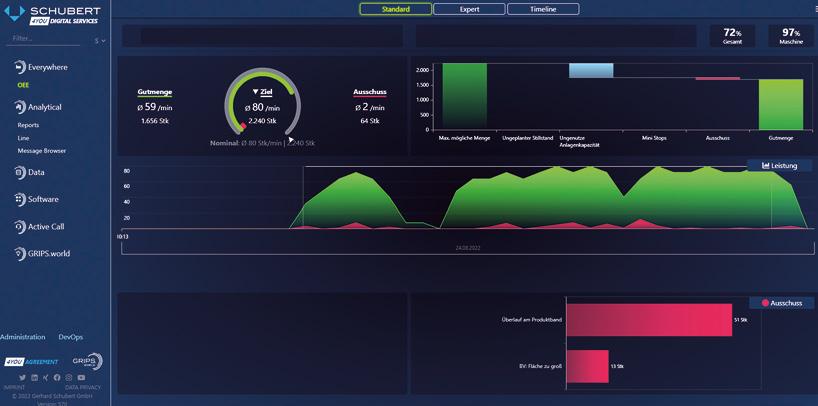
34 italian food & packaging technology - civ (2023) - september
The data evaluation of Schubert machines on the customer portal is currently being optimised for even better user-friendliness.
products and ready-to-sell packaging – and the more sustainable the entire manufacturing process of an FMCG manufacturer will become. It enables companies to improve their carbon footprint and is well received by consumers. Two key factors need to be considered to successfully manage radically changing requirements: Automation and digitalisation. And yes, both play hand in hand. Efficiency and sustainability are most likely to be achieved through automated processes that can be continuously monitored digitally and adjusted or improved as needed. Especially with the food sector’s large product volumes and highly perishable goods, every unplanned machine stop instantly results in product rejects and higher costs, including the ecologically questionable topic of wasted food. The ambitious goal for producers should therefore be to achieve flawless production without unplanned stops and rejects. This is difficult to achieve without a precise analysis of possible weak points, identified long before any unplanned stop. And this is exactly where digitalisation comes in.
Tremendous potential for more efficiency
The masses of data generated in modern production lines represent a virtual gold mine that can be exploited with the right expertise. Data evaluation at various levels makes every machine transparent: It provides valuable input for optimising existing processes, useful information on when and which maintenance of individual machine components should take place, or even initial error messages that indicate an impending
problem. The key is to select the important data from the multitude of individual raw data – such as the temperature sensor on a robot motor or the error message on a glue nozzle – to then condense it and draw the right conclusions. Big Data is the starting point, but it is the fine-tuning that brings the desired results and an increase in efficiency, quality and sustainability. There are numerous unexploited and perhaps even unimagined opportunities for manufacturers to make their production more cost-effective and ready to take on new challenges.
Identifying and clearing obstacles
One of the most frequent topics of discussion in industry is the analysis of machine data. It is, in fact, something that promises manufacturers many advantages – if only it weren’t for the unresolved issues of data protection and legal certainty between machine operators and machine manufacturers. Who owns which data? Who is allowed to store it, evaluate it, or even pass it on, and how? So far there are no standards for all of this. In principle, a contract or licence has to be concluded between the partners for each individual case. The “Guidelines for Data Use” defined by the VDMA (German Engineering Federation), which includes not only German but also other European companies, provides some guidance. Ultimately, however, a high degree of trust is needed between the business partners, all the more so when it comes to the sensitive issue of monitoring competition. There is also a second obstacle which has very different implications depending on the
company: Digitalisation and data use cannot be achieved without a company’s IT department. As diverse as individual manufacturers are, so too are their IT architecture, network structures and corresponding IT policy – which sets rules for the use of all hardware and software, including data processing, for employees. All in all, this is an extremely complex field that requires a great deal of expertise and on which the main responsibility for data security hinges. The trade-off between protection and progress at this point is a difficult balancing act for all parties involved, including managing directors, IT experts, skilled workers and machine operators from production.
The issue of data security
Schubert, the packaging machine manufacturer, has experienced this directly. And it offers its customers the possibility to evaluate the raw data of Schubert machines specifically for them, for example to eliminate faults more quickly, introduce preventive maintenance or increase a packaging machine’s performance. This takes place via a cus-

packaging equipment italian food & packaging technology - civ (2023) - september 35
Uwe Galm, Director of Customer Services at Gerhard Schubert GmbH
tomer portal in which the data is collected and presented in different analyses with varying levels of detail. Operators therefore have to decide whether to grant Schubert access to the customer portal via the internet to benefit from the services. Uwe Galm, Director of Customer Services at Gerhard Schubert GmbH, reports: “The decision for or against our digital CARE Services is often determined by the various interests within a company, the existing IT architecture and the IT policy. We often see that investments in digitalisation have already been made. However, it is often not possible, especially for medium-sized businesses, to build up the necessary expertise to enable strategically meaningful data analysis in-house – quite simply due to the demanding nature of the subject matter. Our service experts can close this gap.”
Uwe Galm understands that the human factor should not be underestimated: “Our customers’ concerns are extremely important to us and are always an incen-
tive to do better. This is why our GS.Gate industrial gateway, which we co-developed, is installed in all new Schubert machines. It meets the latest IT security requirements by separating customer networks

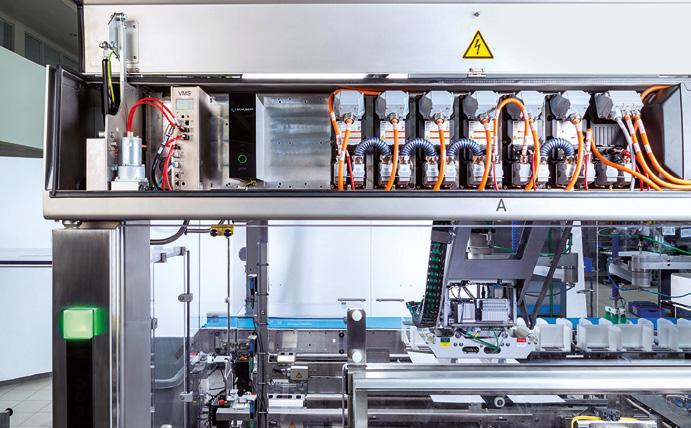
from the internet. The machine data is collected on the gateway similarly to edge computing and displayed in the customer portal on request. By the way, we are currently revising the presentation of this data in the portal itself together with some of our customers to make it even more user-friendly.” Schubert only gains access to the portal from the outside if the customer agrees. Uwe Galm adds: “During access, the security of the customer network is always ensured by the GS.Gate’s unique architecture.”
Added value in practice
Schubert considers it very important to position its customers to successfully meet the challenges of the future. “For us, this most definitely includes making use of new digital technologies. Above all, we have to explain to our customers the added value these advances can generate,” highlights Uwe Galm. This is why the machine manufacturer not only offers a test stand with clearly illustrated real machine examples, but also free use of the customer portal for 30 days. For some companies, the digital services are already yielding visible successes. For example, the customer portal quickly put the Schubert experts on the right track when troubleshooting a customer’s line, and food manufacturer Kühne was able to significantly increase the performance of its line together with Schubert through OEE analyses.
(Gerhard Schubert GmbH
- Industriegebiet SüdostHofäckerstraße 7 - 74564 Crailsheim
- Germany - Tel. +49 7951400-0e-mail: info@gerhard-schubert.de - www.schubert.group)
packaging equipment 36 italian food & packaging technology - civ (2023) - september
All new Schubert machines are equipped with the GS.Gate industrial gateway. The machine data is collected on the gateway in a manner similar to edge computing and displayed in the customer portal on request.
The gateway, jointly developed by Schubert System Elektronik and genua, meets state-of-the-art IT security requirements by keeping customer networks and the internet separate.
Being flexible is good, being fast and flexible is even better. Schubert packaging machines are leading the way. Intelligent control and precise robotics can now replace complex mechanics to ensure maximum flexibility in all packaging processes. In fact, 80% of the leading FMCG companies count on us and our flawless packaging combined with the lowest possible consumption. In line with our Mission Blue Sustainability Initiative: A winning proposition – for our planet and for you. www.schubert.group/en/food.html

AS FAR AS YOUR EYES CAN SEE: INFINITE OPTIONS FOR PACKAGING FOOD. BROUGHT TO LIFE WITH SCHUBERT.
SMI solutions for Arden’s Garden juices

This is what Arden Zinn always thought, a woman dedicated to the well-being of others, who, starting from a simple juicer, founded the company Arden’s Garden, one of the most important companies in the United States for the production of juices, fruit extracts and healthy, genuine food. These simple assumptions were the basis for the creation and growth of a modern company that uses packaging systems of the latest generation, such as the ASW 50 F ERGON automatic shrink wrapper by SMI for the packaging of several types of 15.2 oz and 2 oz PET bottles in film only.
The benefits of fruit extracts
Fruit and vegetables are a real concentrate of health; ex-
tremely rich in vitamins and minerals, these foods are the fuel for the human body, readily available and easy to digest. Arden’s Garden company produces a wide range of cold-
pressed juices, a system that does not use heat, oxygen or other pasteurization methods, thus preserving the healthy and curative properties of fruit and vegetables. The American company also produces other delicacies rich in nutrients, such as raw vegan snacks, made with nuts, rolled oats, kale, cashews, almonds, peanut butter and chocolate.
SMI solutions for Arden’s Garden
Arden’s Garden produces a very wide range of fruit juices in 15.2 oz and 2 oz PET bottles, packed in packs in film only by SMI shrink wrapper from the ASW 50 F ERGON range, equipped with a 90° product feeding system. To meet the requirements of such a varied production, the company founded in 1995 by Arden Zinn, uses extremely flexible SMI systems, that, thanks to innova -
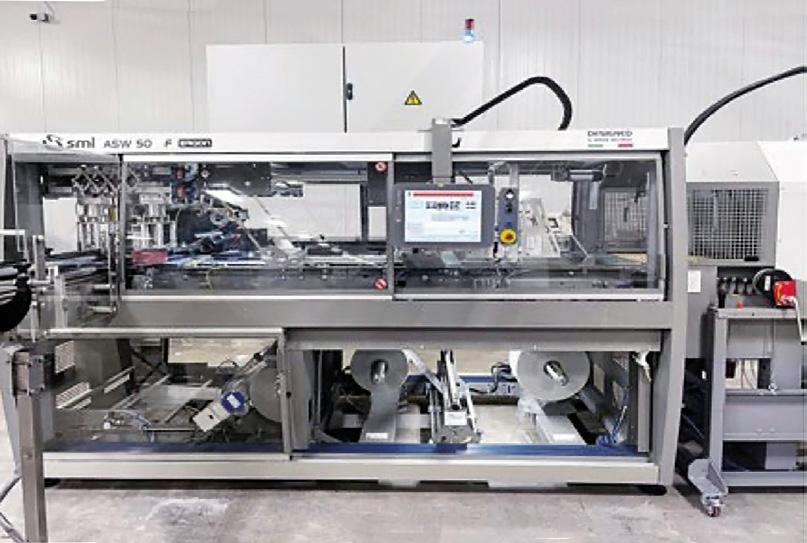
packaging equipment 38 italian food & packaging technology - civ (2023) - september
t ive technical solutions to perform easy, fast and cost-saving format changeover, meet the needs of a constantly changing market.
Main advantages
• The ASW 50 F ERGON shrink wrapper is a compact solution that easily adapts to end-of-line logistic conditions and meets production requirements up to 50 packs/ minute
• Ergonomic structure: the single-lane entry facilitates the correct channeling of loose containers on a conveyor belt equipped with low friction thermoplastic chains
• Reduced size thanks to the machine product entry with 90° configuration
• Machine equipped with single-lane conveyor: a divider is not required for the product
channeling, with consequent economic advantages
• Loose products are pushed from the infeed to the packaging conveyor smoothly and
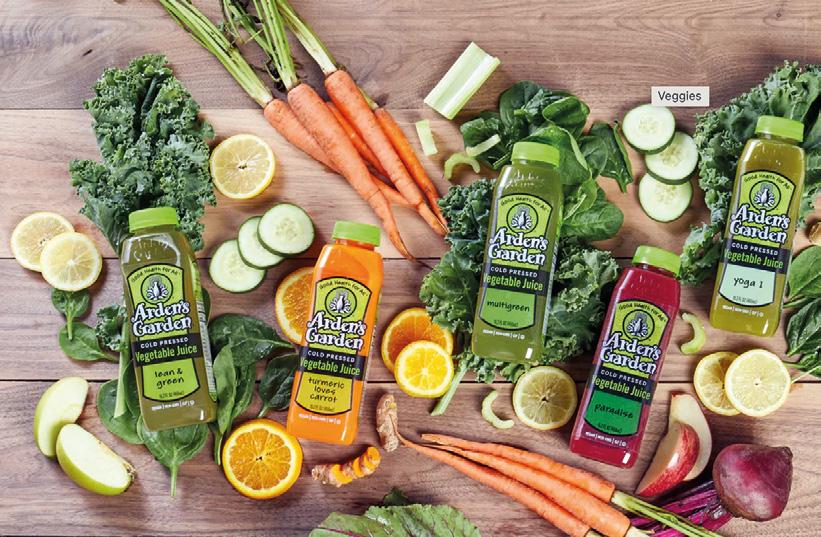
efficiently thanks to a rotating infeed
• Easy, fast and cost-saving format changeover: the single-lane entry offers the ad-
vantage of processing different types of containers, of various sizes, without having to use additional belt equipment
• Precise and accurate film cutting operations thanks to the blade controlled by a direct-drive brushless motor
• High operational flexibility: the ASW range is suitable for processing a wide range of containers with cylindrical, oval or square/rectangular base.
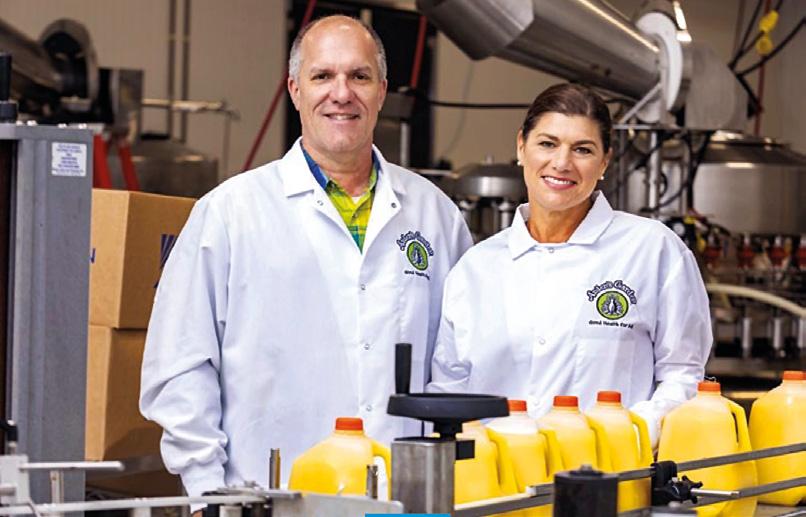
• Simplified maintenance.
(SMI - Via Carlo Ceresa 1024015 San Giovanni Bianco - BG - Italy - email: info@smigroup.itwww.smigroup.it)
packaging equipment italian food & packaging technology - civ (2023) - september 39
ILPRA Group: the single destination for total packaging solutions
Since its entrance into the Italian Stock Exchange in 2019, ILPRA has been making clever acquisitions of made in Italy packaging companies, with the aim to create a versatile catalog and offer to its customers complete packaging solutions.
To meet the demands of an increasingly specialized, automated and evolving market, to its wide range of tray sealers, filling and sealing and thermoforming machines, ILPRA decided to integrate its offer with cutting-edge packaging equipment. The birth of the group comes from the desire to provide complete solutions and extend its portfolio with cross-cutting technologies that can meet any type of production
need. Today the ILPRA Group boasts the presence of consolidated manufacturing realities of made in Italy such as Veripack,
Strema, Macs, Pentavac, and IDM Automation. From tray sealers to thermoformers and vertical form fill seal, ILPRA has the answer to every requirement.
Veripack was one of the first companies that joined the group. Thanks to its complementary catalog of high-level thermoforming machines, the company filled ILPRA’s need to offer thermoformers for large production in the food and medical sectors. Among the many things ILPRA and Veripack have in common there is a strong emphasis on flexibility and customization. Veripack in fact designs and manufactures solutions tailored to the specific needs of each customer.
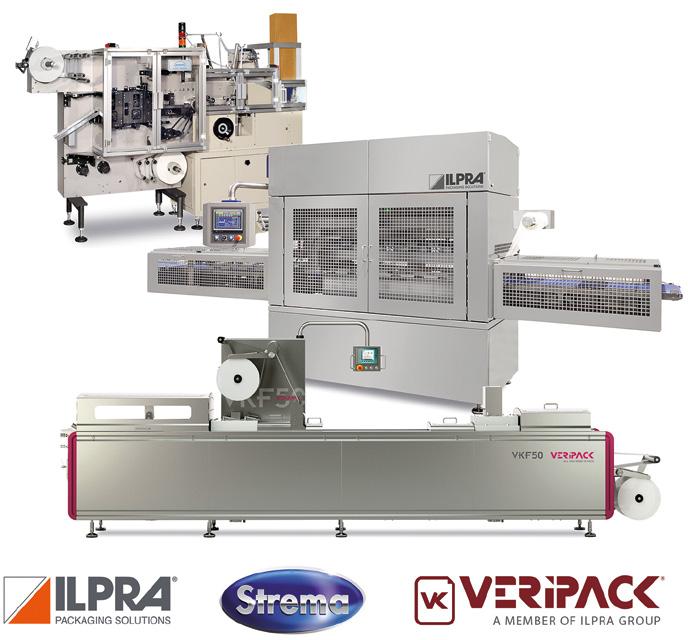
In the same year, Strema entered the ILPRA Group enriching the offer with packaging solutions for the medical and personal care industry. Their offer includes several fields of appli-

packaging equipment 40 italian food & packaging technology - civ (2023) - september
cation, including the packaging of cotton swabs, cosmetic pads, medical applicators, and paper sticks.
Since flexibility it’s not only a value, but also a shape in the packaging glossary, ILPRA confirms its strategy by acquiring MACS. Based in the heart of the packaging valley, the company specializes in the production of technologies for doypack, sachet, pouches, and sticks packaging. By joining forces with MACS, ILPRA gains valuable expertise in flexible packaging, which is currently a trending market in the packaging industry, mainly due to the recent storage and informative needs required by packs.
During this year, other two well-known companies became part of the ILPRA Group. The first one is Pentavac that design and manufacture automatic vertical packaging lines, weighers and transport systems. With a wide catalog and more than 25 years of experience, the company offers high quality solutions including flexible packaging options such as pillow, stable, pouches, and doypacks. Pentavac plays a key role in integrating different production systems. Its technologies, especially the relevant dosing, weighing, counting and transport systems for the product are fundamental elements in the development of a production line. This has led the company to be a well-known reality both nationally and internationally.
The latest and most recent milestone is the acquisition of IDM Automation, a young company specialized in machines for processing and packaging cosmetic and personal care products. From the design of customized systems, up to the manufacture,
installation and after-sales assistance, IDM Automation is the answer to the innovation needs of the cosmetic and pharma industries.
At Cibus Tec, visitors will have the chance to see some of the innovative solutions proposed by the ILPRA Group. In addition to ILPRA, Veripack and Pentavac booths, the synergy and integrability of the technologies offered by the group will be proved with three demonstration lines. These live demonstrations aim to showcase the latest solutions dedi-
cated to the food industry and represent a unique opportunity to deepen sustainable technologies for cardboard, vacuum and doypack packaging.
This event represents an exceptional occasion to discover the entire group, because ILPRA can be your next partner for your production, offering complete packaging lines for every need and industry.
(ILPRA - Via Mattei, 21/23 - 27036 - Mortara - PV - ItalyTel. +39 0384 2905 - email: info@ ilpra.com - www.ilpra.com)
New bioplastics based on polybutylene succinate (PBS)

Sea and environmental pollution due to microplastics are global problems that in recent years have attracted particular interest in the scientific community. The increase in the world population and the consequent
consumerism of non-reusable materials are amplifying these problems.
In a manuscript published in Polymers journal, Italian Researchers present novel bioplastics, which are completely
packaging equipment italian food & packaging technology - civ (2023) - september 41
biodegradable, for their potential use in food packaging, to replace fossil-fuel-derived plastic films and slow food degradation due to oxidative processes or microbial contamination. In this study, thin films based on polybutylene succinate (PBS) were prepared to reduce pollution, and different percentages by weight (1, 2 and 3 wt%) of extra virgin olive oil (EVO) and coconut oil (CO) were included to improve the chemico-physical properties of the polymer and possibly im-
prove the functionality of the films in terms of prolonged food preservation. Attenuated total reflectance Fourier transform infrared (ATR/FTIR) spectroscopy was used to evaluate the interactions between the polymer and the oil. Furthermore, the mechanical properties and thermal behavior of the films were evaluated as a function of the oil content. A scanning electron microscopy (SEM) micrograph showed the surface morphology and the thickness of the materi-
als. Finally, apple and kiwi were selected for a food-contact test, and the wrapped sliced fruit was monitored and evaluated for 12 days to macroscopically evaluate the oxidative process and/or eventually occurring contamination.
The films were shown to reduce the browning of sliced fruit due to oxidation, and no molds were evidenced up to 10/12 days of observation with the addition of PBS, with 3 wt% of EVO achieving the best outcomes.
Improving the sterilization of PET bottles
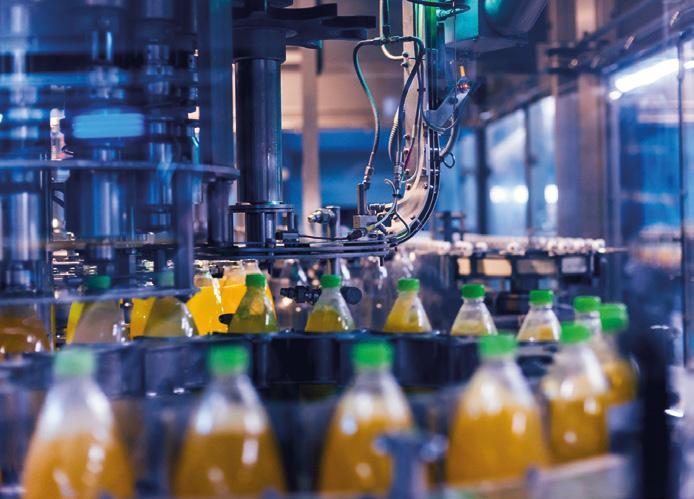
Hydrogen peroxide vapor sterilization of containers is commonly used in aseptic filling processes for liquid food such as dairy products. The sterilization of polyethylene terephthalate (PET) bottles presents a considerable challenge because of their temperature sensitivity. Therefore, the influence of the vapor temperature between 65°C and 115°C was considered, as it was significantly higher on other substrates in previous studies.
An extensive Design of Experiments was conducted by German Researchers to determine the effects of different parameters and their interactions on the count reduction rate. The maximum observable count reduction rate was log (N0/N) = 6.6 for Bacillus atrophaeus DSM 675 spores. The count reduction rate could be positively influenced by increasing the gas temperature at liquid hydrogen peroxide (35% (v/v)) amounts above 0.186 mL
for 500 mL bottles. Gas temperatures above 80°C, in combination with the injection of vaporized H2O2 twice instead of once, increased the count reduction rates. By preheating the PET bottles to at least 35°C and using a gas temperature of 80°C, count
reduction rates were higher than at lower temperatures.
According to the work published in Food Packaging and Shelf Life journal, not only the individual parameters but also their combinations had a significant effect on the inactivation of the spores.
packaging equipment 42 italian food & packaging technology - civ (2023) - september
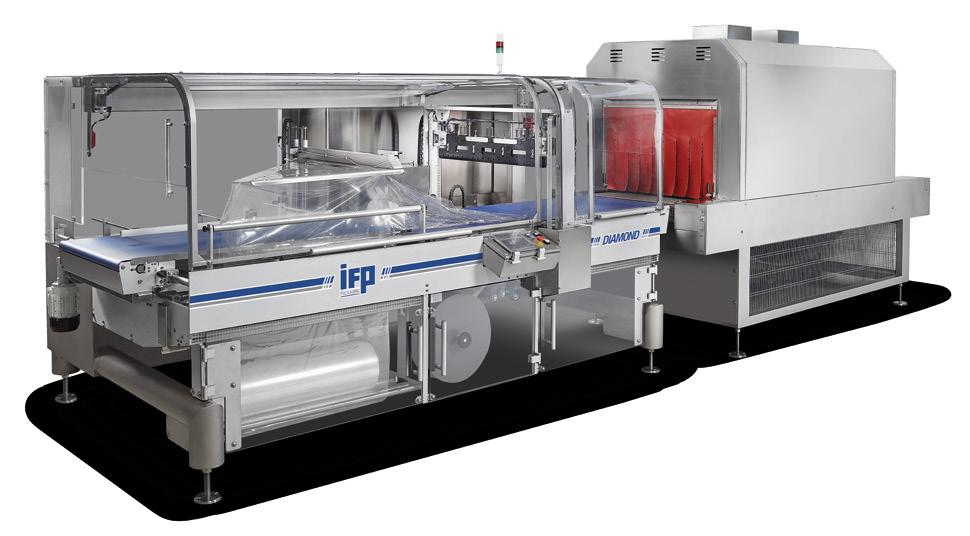


Optimizing consumer acceptability of chocolate through roasting treatments

Chocolate is a highly appreciated food around the world which is rich in polyphenols but usually sweetened to mask inherent bitterness and astringency. US Researchers determined how roast time and temperature in cacao roasting affect bitterness intensity and consumer liking of chocolate. They have also determined the relationship between consumer liking and per-
ceived bitterness, astringency, sourness, sweetness, and cocoa intensity. The results were published in Current Research in Food Science journal.
Unroasted cacao from three different origins was roasted according to a designed experiment into a total of 27 treatments which were evaluated for overall liking and sensory attribute intensities by 145 chocolate
consumers. They demonstrated that bitterness, sourness and astringency of 100% chocolate can be reduced through optimizing roasting temperature and time. Reduction of bitterness, sourness and astringency were significantly correlated with increased acceptability of the unsweetened chocolate samples. Aside from roasting, cacao origin including base levels of bitterness, astringency, and sourness should also be considered when optimizing consumer acceptability. Perceived cocoa flavor intensity, being highly positively correlated to liking, is likely to also be an important consideration for raw material selection.
As for optimal roast profiles, for the cacao origins in this study, more intense roasting conditions such as 20 min at 171°C, 80 min at 135°C, and 54 min at 151°C, all led to the most acceptable unsweetened chocolate. Conversely, for the purposes of optimizing consumer acceptability, these data do not support the use of raw or lightly roasted cacao, such as 0 min at 24°C, 11 min at 105°C, or 55 min at 64°C.
44 italian food & packaging technology - civ (2023) - september
NUTRITION
A novel mayonnaise-type dressing added with avocado pulp and oil
In a Mexican study published in CyTA - Journal of Food, avocado pulp and oil were added to mayonnaise type-dressing to produce a healthy and microbiologically safe product with improved sensory properties.
First, oil avocado was obtained by solvent-free ultrasonic-assisted extraction and centrifugation. The mayonnaise type-dressing was formulated with avocado pulp and oil and then treated with ultrasound. Chemical and sensory qualities were determined in the oil.
Microbiological quality, color and sensory analysis were carried out in the mayonnaise type-dressing along a storage period under re-
frigeration. The avocado oil yield was 64% with an outstanding emerald green color. The avocado oil quality agreed with Mexican Official Standards. Oleic, palmitic, palmitoleic and linoleic acids were found to be the major fatty acids in avocado oil.
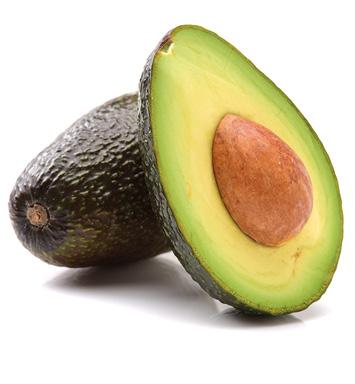
The mayonnaise-type dressing showed a reduction of the microbial load without the need for thermal pasteurization, and the green color was stable during storage. Color, odor and flavor were sensorially evaluated as “like much.
Developing a herbal drink from green asparagus
Green asparagus is widely consumed fresh due to its high nutritional value and a low calorie content. However, its short shelflife due to a high water content causes high postharvest losses.
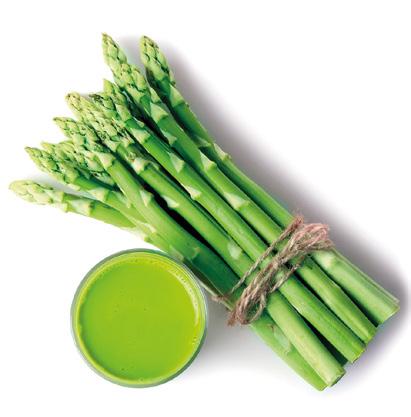
In a study published in Food Processing: Techniques and Technology, Vietnamese Researchers aimed to develop an innovative asparagus herbal drink to ease postharvest losses and diversify asparagus-derived products. They investigated the effects of process parameters on the quality of the herbal drink from green asparagus. In particular, we determined the optimal length and grinding size for asparagus and selected suitable blanching and drying methods. Analytical responses included the contents of total soluble solids,
polyphenol, carbohydrates, and vitamin C, as well as the visual appearance of asparagus samples. The length of 5mm was found suitable for subsequent steps as it facilitated an increase in solute in the asparagus infusion. Microwave blanching and convective drying were selected to achieve high contents of total soluble solids, polyphenol, carbohydrates, and vitamin C in the asparagus infusion. Dried asparagus ground into 1.5-2.0mm particles was packaged into tea bags. The asparagus infusion subjected to sensory evaluation had a yellowish color, a characteristic asparagus flavor, and a relatively sweet taste. Total soluble solids in the infusion amounted to 26%. Theresults showed a possibility of developing an asparagus herbal drink which could be a po-
tent product in the commercial market. Therefore, further largescale studies of the asparagus herbal drink should be carried out to enhance its feasibility in the food industry.
nutrition italian food & packaging technology - civ (2023) - september 45
Effects of various milk powders on cocoa butter substitute-based chocolate
Optimal conditions for formulation of cocoa butter substitute (CBS)-based milk chocolate produced in a ball mill with hydrogenated palm kernel oil stearin as CBS were defined by German Researchers using a D-optimal mixture design.
In the formulation of chocolate samples, various amounts of whole milk powder, skimmed milk powder and demineralised whey powder were used and their effect on physico-chemical, colour, texture, and sensory properties were investigated. The fitted models demonstrat-
ed significant effects of independent variables on various quality parameters. Optimum formulation for selected parameters to maximise taste and minimise whole milk powder content as well as reduce costs were determined. Moreover, the optimum formulation was produced to validate the optimum model.
Results of the validation were consistent with the findings of the model study. Furthermore, the approach used in this work published in the International Dairy Journal could be employed
Saltiness enhancement of bread
The current global sodium consumption exceeds recommended daily intakes and there is a great need to reduce the sodium content in foods for a healthier society. For this pur-
pose, a Swedish study investigated the effect of combining sensory interaction principles and heterogeneous distribution of NaCl in bread on sensory properties, structure, and NaCl distribution.
Breads were prepared in three different arrangements of NaCl distribution: homogenous, layered, and layered with lactic acid. Within each arrangement, four NaCl levels were tested. The breads were evaluated by a sensory panel for perceived saltiness, sourness, and qualitative texture, measured for stiffness, and the NaCl distribution was determined by X-ray fluorescence microscopy (XFM). Perceived saltiness was significantly enhanced in breads be-
to develop strategies to produce CBS-based milk chocolate with lower costs and various quality properties.

yond heterogeneous NaCl distribution when lactic acid was added. Stiffness measurements were affected by layering of bread, the layers without NaCl were stiffer with an increase in overall salt concentration. The heterogeneous distribution of NaCl in layered breads could be visualised by XFM and textural consequences of layering bread are discussed.
This study published in LWT - Food Science and Technology journal demonstrates the potential of combining principles of pulsation of taste and sensory interactions together to enhance salt perception, and hence suggesting the approach as a possible further strategy for NaCl reduction in bread.

nutrition 46 italian food & packaging technology - civ (2023) - september









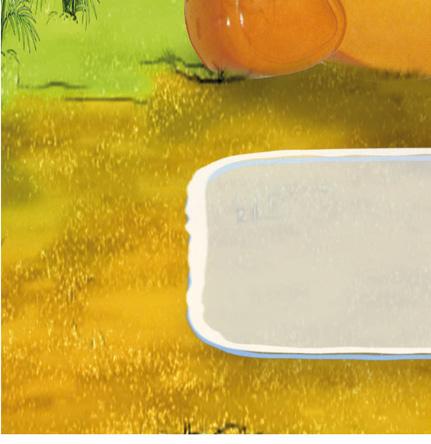


RESEARCH
Rapid determination of the roasting degree of cocoa beans
The determination of the levels of roasting of cocoa relies on expensive analytical equipment, sensory panel, and, in the cases of small processors and growers, empiricism.
In this Canadian study published in the Journal of Agriculture and Food Research, cocoa beans were roasted for 10-40 min to obtain different levels of roasting, and the images of the beans were captured by a smartphone camera. An extreme learning machine (ELM)based algorithm was developed to predict the roasting degree of cocoa beans using the images of the cocoa bean cross-sections. A 22-dimension feature vector, including color and texture features, is extracted from each sample, and a total of 350 samples are used to train an ELM network. A majority rule-based voting method was used to make the decision. Experimental results showed that the proposed method achieved a classification accuracy of 93.75%. GC-MS analysis was conducted to determine the chemical compounds in the raw and roasted cocoa beans, and enrichment analysis, principal components analysis, partial least-squares-discriminant analysis, and Pearson correlation analysis were conducted to identify major chemicals respond to

roasting time and classify the cocoa beans samples. Caffeine and theobromine were identified as primary chemical compounds that responded to roasting time, and cocoa beans with different levels of roasting were successfully classified.
New method to produce skim milk concentrate
Skim milk concentration is an energy-intensive process and is a prerequisite step during skim milk powder production. To achieve a high dry matter (DM) of 40%, a mild and thermal energy-saving, two-stage membrane cascade consisting of reverse osmosis (RO) and nanofiltration (NF) was developed as an addition to the conventional evaporation process.
In the study published in the Journal of Food Engineering, German Researchers investigated the effect of different processing parameters (temperature and transmembrane pressure) and membrane parameters (feed spacer thickness, feed spacer geometry, and membrane material) during the filtration stages. Recirculating the NF permeate
back into the RO feed stream produced an NF retentate that had a composition similar to that of the skim milk concentrate obtained by the evaporation process. The membrane filtration cascade that was developed enabled the production of highly concentrated skim milk under mild processing conditions.

48 italian food & packaging technology - civ (2023) - september
Applications of various natural pigments to a plant-based meat analog
To imitate the color of meat after cooking, natural pigments (red beet, monascus red, oleoresin paprika, sorghum, and cacao) were applied to a plant-based meat analog patty (PBMA).
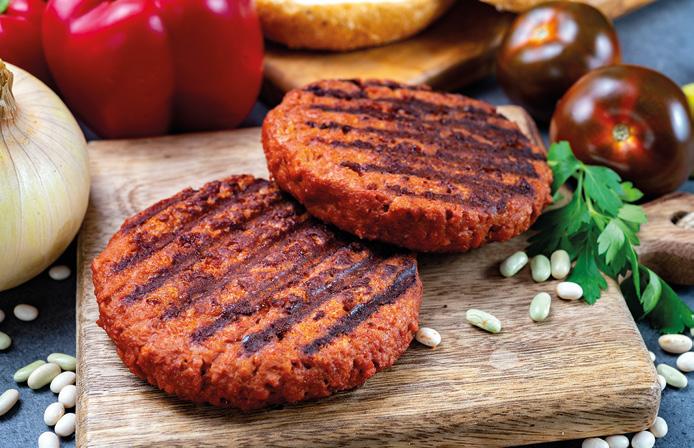
The target color ranges (external- and internal-cooked) for PBMA were set separately by evaluating the color values (L*, a*, and b*) of a Hanwoo (Korean native cattle) beef rib patty (HR). As a result of adding different levels of each pigment, the PBMA with cacao (1.0 mg/g) and sorghum (3.0-4.0 mg/g) pigments matched the externaland internal-cooked target ranges, respectively; however, adding a single pigment to PBMA insufficiently mimicked the external- and internal-cooked target ranges. To overcome the above limitations, red beet and cacao pigments were selected, and the color values of the PBMA with these pigments were optimized
using response surface methodology. Korean Researchers obtained the optimized mixing ratio (0.4-1.5 mg/g of red beet and 1.11.3 mg/g of cacao pigments) and the sensory evaluation showed the color of PBMA with optimum pigments was most similar to
HR, increasing appearance, overall acceptability, and purchase intention. These findings published in LWT - Food Science and Technology journal suggested that the cooked meat color can be mimicked by applying natural pigments to PBMA.
Valorization of industrial spent coffee grounds
The main by-product of the coffee industry is spent coffee grounds (SCG) and this industrial SCG has been used by Colombian Researchers to build a batch-valorization line combining barrel coffee roasters as an innovative drying process and ultrasound-assisted extraction technology under the biorefinery concept, seeking to extract chlorogenic acids (CGA).
A Probat Sample Barrel Roaster
were used to determine the optimal temperature, volume flow of fan, and time for a novel drying method. Drying optimization was carried out in order to reach 5.0% moisture content, reduce water activity and maximize total CGA content. Optimal conditions of 140°C, 160.0m3h-1 and 11.43 min for temperature, volume flow of fan, and time, respectively, were obtained with a desirability of 70%. Likewise, the optimal tem-
perature, power and frequency settings for an ultrasonic extraction procedure of CGA from dried SCG were evaluated. To maximize the total CGA content, the ultrasonic technique was optimized. Temperature 50°C, frequency 37kHz and power 100W with a desirability of 80% were necessary for optimality. The study published in the Journal of Chemical Technology and Biotechnology was completed
research italian food & packaging technology - civ (2023) - september 49
with a kinetic analysis using a second-order rate model, Peleg’s kinetic model and the phenomenological model.
In conclusion, industrial coffee by-products can be processed and valorizing using barrel coffee roasters as a novel technique. For process design, the kinetic parameters of ultrasound-assisted extraction are a helpful tool. A new mathematical model is presented that takes into account the impact of changing temperature on the ultrasonic process.
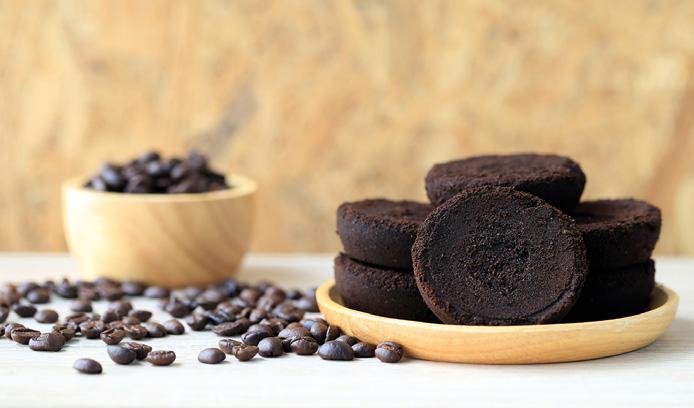
Protein modifications due to homogenisation and heat treatment of cow milk
A research paper from New Zealand published in the Journal of Dairy Research aimed to locate protein modifications caused by treatment of milk and determine if the modification locations were consistent.
The majority of milk for consumption is homogenised using pressure and heat, and this causes changes in the location of proteins in the milk as well as protein modifications.

To investigate these proteomic changes, raw milk was pasteurised (72°C, 15 s), then, to separate the treatment for homogenisation, heated at these different pressures and temperatures: 45°C without no pressure applied, 45°C with 35 MPa, 80°C without pressure applied and 80°C, with 35 MPa. Proteomic analysis was done after separating the milk into three fractions: whey, casein and cream.
Protein modifications in each fraction were examined and we found Maillard products as well as oxidation to be of interest.
The proteins were also further identified and characterised to compare protein modification sites and differences in proteins present in the cream resulting from homogenisation and/or pasteurisation.
This experiment showed that both heat and pressure during homogenisation can cause increases in protein modifications as a result of oxidation or the Maillard reaction. Total cysteine oxidation and total proline oxidation differed between treatments although this was only significantly different for cysteine.
It was observed that protein modifications occurred in the same location in the protein sequence rather than in random locations which we highlighted by examining alpha-S1-casein, lactadherin and beta-lactoglobulin.
research 50 italian food & packaging technology - civ (2023) - september

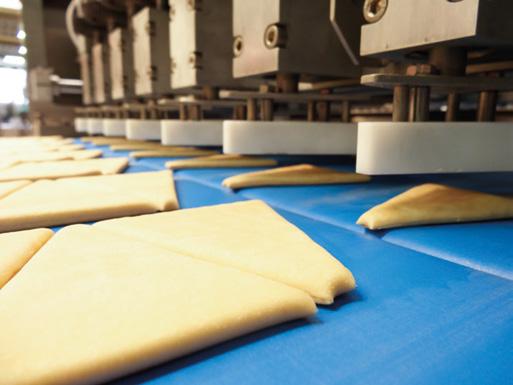
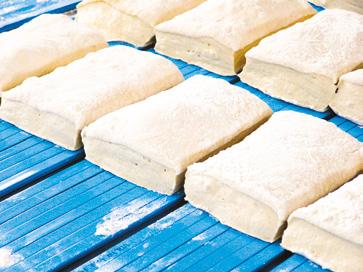
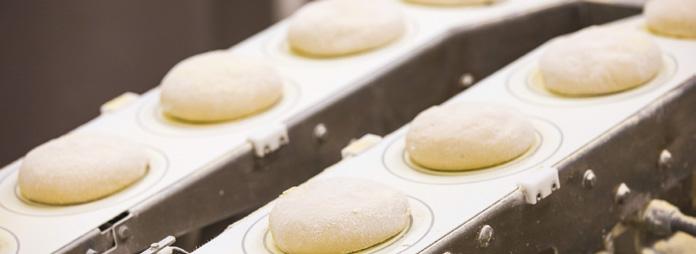
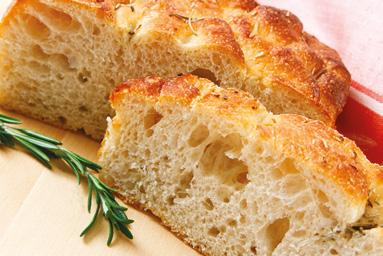


Gluten freeLactose freeVegan OrganicHealty foodEco-friendy ALBA Equipment introduces its wide range of FREE-FROM lines! We can process any special dough required more and more by the worldwide Alba & Teknoservice S.r.l. Via delle Industrie, 26 - 35010 Villafranca Padovana (PD) Italy Telephone: +39 049 9070380 - Email: info@albaequipment.it www.albaequipment.it ALBA EQUIPMENT FREE-FROM GIVES YOUR FREEDOM!
Influencing factors of oil deterioration during frying
The effects of frying time, frying method, frying temperature, frying ingredients and types of frying oil on the polar components content and acid value of frying oil were studied by Chinese Researchers, and the effective measures to control the oil deterioration during frying were analyzed.
The results published in the China Oils and Fats journal showed that the polar components content and acid value of frying oil increased with the prolonging of frying time, and continuous frying was better than
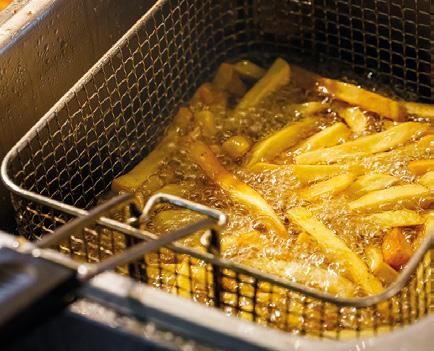
intermittent frying. The higher the frying temperature was, the faster the oil deterioration would be, and the faster the polar components content and acid value of oil rose. In order to ensure the hygienic quality of fried food and extend the service life of frying oil, the setting control of frying temperature was less than 200degreeC. The influence of fish cake on the deterioration of frying oil was the biggest, followed by chicken leg steak and french fries. The changes of polar components content and acid value in different frying oils
were different. Soybean oil with higher polyunsaturated fatty acid content was more prone to hydrolysis and oxidation than rice bran oil and palm oil, and the frying period of rice bran oil was close to palm oil.
Enhancing emulsifying and encapsulation properties of plant proteins
Improving the functionality of commercial plant proteins is essential for food application.

An alternative strategy is provided by Australian Researchers to modify the structure of pea protein by microbial transglutaminase-induced cross-linking with whey protein for enhancing emulsifying and encapsulation properties.
The protein structures and the physicochemical stability of beta-carotene-loaded emulsions were investigated subject to protein ratio and cross-linking. Formation of disulphide and isopeptide bonds between heteroproteins according to cross-linking changed protein structures by exposing the hydrophobic sites of proteins with stiffer network. The cross-linked pea/whey protein
complexes at protein ratio of 2:1 formed a stable emulsion with a droplet size of 0.10 µm, showing no phase separation for 30 days of storage and high encapsulation efficiency of 92%.
These findings published in Food and Bioproducts Processing
journal provided a novel strategy to design plant/dairy protein networks to protect lipophilic bioactive compounds by replacing half or more dairy protein with plant protein, leading to gradual change towards plantbased diets.
research 52 italian food & packaging technology - civ (2023) - september
Effects of high hydrostatic pressure treatment on the digestive properties of whey protein
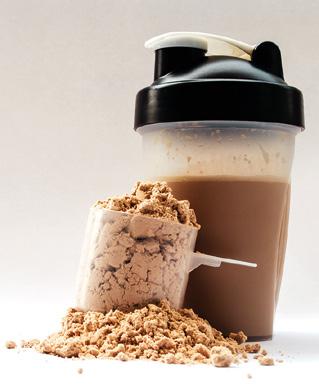
The effects of high hydrostatic pressure (HHP) treatment and in vitro simulated infant digestion on the antigenicity of whey protein concentrate (WPC) were investigated by Chinese Researchers and the results revealed that the greatest decline in allergenicity was observed at 500 MPa for 10 min, which was 76.19% ±1.45%. HHP treatment (500 MPa/10 min) contributed to WPC structure stretched as beta-sheet content increased from 18.45% ±0.32%-20.93% ±0.59% (p < 0.05). Fluorescence spectroscopy indicated the fluorescence intensity increased from 4.649 x 106 to 5.205 x 106 with the increased HHP time (0-15min). There was a 1.39-
fold increase in hydrophobicity of HHP-modified WPC which was the equilibrium result of protein unfolding and intermolecular ag-
gregation. HHP treatment (500 MPa/10 min) facilitated the conformational changes of WPC that were needed to increase the effectiveness of in vitro simulated infant digestion, and increased the content of peptides with molecular weights below 10,000 Da in digestion products by 9.99%. HHP pretreatment prior to in vitrosimulated infant digestion reduced the retention of WPC antigenicity to the lowest level, which was 38.96%.
Overall, this study published in LWT - Food Science and Technology journal suggests that appropriate HHP treatment could be a promising technique to improve the digestibility of milk proteins and reduce their antigenicity.
Thermal treatment of green barley malt to produce functional clean-label ingredients
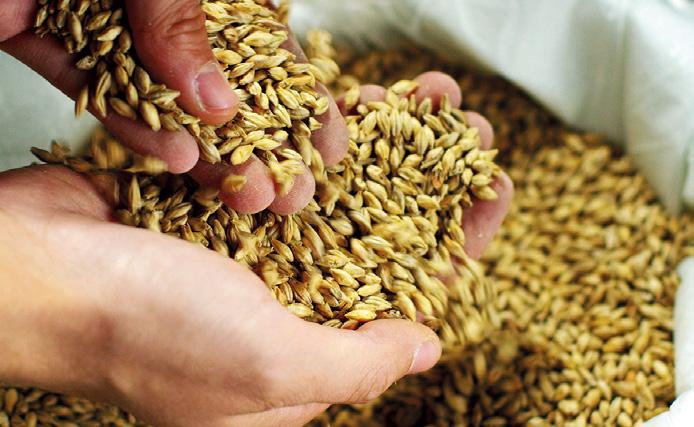
Malt flour represents a potential clean label bread improver, but a high enzymatic activity can lead to some bread defects. Thus, a Brazilian study was focused on applying different thermal treatments (10 and 40 min; 70-90°C) to green barley malt in order to promote a partial enzyme inactivation and the results were published in Food Research International journal.
The addition of 1.5 g of thermally treated malt (TTM) per 100 g of flour in wheat bread formulation was evaluated regarding the resulting bread-making prop-
research italian food & packaging technology - civ (2023) - september 53
erties, dough fermentation and overall bread quality. Activity of starch-degrading enzymes was not detectable above 80°C/10 min. TTM incorporation improved the gas production by up to 60% during fermentation, mainly in formulations to which malts thermally treated under mild conditions have been added. Compared to untreated malt, thermal treatment reduced dough thermal weakening, improved gel strength during gelatinization and maintained low setback val-
ues. Bread collapse observed by baking follow-up was related to gas inflation and low mechanical resistance.
Formulations with the addition of malts thermally treated at 70°C for 40 min resulted in breads with higher specific volume, improved coloration and a crumb with slightly smaller pores than control and untreated malts. Thus, thermal treatment can be used as a technique to produce standardized malted flour to be used as clean label bread improvers.
Decaffeination of coffee and tea using mid-infrared rays
Coffee (Coffea arabica) and tea (Camellia sinensis) are beverages consumed widely across the globe. Flavor enhancement of beverages is the prime interest for consumers and industry, but it is still a major challenge for researchers.

The objectives of an Indian work were to enhance the sensory characteristics and lower the caffeine content of tea and coffee by applying 2-6mum mid-infrared wavelengths emitted through our recently invented Mid-Infrared Generating Atomizer (MIRGA) without creating any adverse effects. Two methods were followed: Direct MIRGA spraying over the packaged coffee or tea powder packets, and direct MIRGA spraying over the liquid coffee or tea. Controls were maintained in both methods. The treated samples were subjected to organoleptic tests by an expert panel and consumers. This study, published in the Heliyon journal, is
supported by comprehensive field trials, including sensory attributes evaluation and laboratory analyses. In coffee, spraying resulted in 8% decaffeination and
increase in theobromine and theophylline by 40% and 10-20%, respectively. In tea, caffeine and theobromine increased by 2025% and 30%, respectively in addition to a 0.6-1.2% increase in thearubigins. A 20-30% lower amount of sprayed coffee or tea powder was required to prepare beverages with regular sensory characteristics.
Researchers have proven that the MIRGA technology applied to the products reduced the caffeine content in coffee, rendered them safe to consume, improved the taste and flavor, and induced health benefits. In addition, as the MIRGA platform contributed toward improving the product characteristics, it can also positively impact their price and affordability. In conclusion, the applications of MIRGA technique and its benefits can be potentially scaled up and utilized for a variety of products used in daily life.
research 54 italian food & packaging technology - civ (2023) - september
Feasibility of protein aerogel particles as food ingredient: the case of cocoa spreads
The feasibility of aerogel particles made of whey protein isolate (WP) as food ingredient was studied for the first time by Italian Researchers.

To this aim, cocoa spreads, which traditionally contain large amounts of solid fat, were prepared using sunflower oil as lipid phase instead of fats. Sunflower oil was mixed with sugar, cocoa powder and WP aerogel particles or unstructured WP (control). Two preparation methodologies were applied: (i) mixing ingredients all at once (one-step) and (ii) preliminary oil absorption into aerogel particles, and sub-
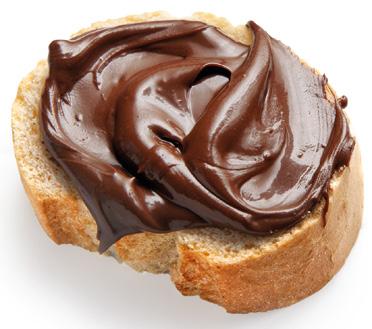
sequent mixing with the other ingredients (two-step). WP aerogel spreads showed higher viscosity than control ones, demonstrating the peculiar functionality of porous aerogel particles in entrapping oil. However, the preparation procedure drove the inter-particle interactions among ingredients. In particular, preliminary oil absorption into aerogel particles (two-step procedure) allowed a stronger network to be obtained.
Results, published in the Journal of Food Engineering, open to the possibility of applying aerogel particles as food in-
Effect of microfiltration on milk protein microstructure
Microfiltration presents a significant opportunity to improve the functional and physical properties of milk proteins and extend the shelf life of dairy products. Commercially filtered milk is available in many main retailers in the UK. Cow’s milk is a major source of proteins for human nutrition. Unfortunately, cow’s milk allergy is one of the most common food allergies in children, affecting up to 3% of the general population. Milk processing may alter conformational and linear epitopes in allergenic proteins thereby changing the allergenicity. Masking of epitopes by a disulphide bond or interaction
of proteins and components of the food matrix, such as fat, are some of the mechanisms that are used to predict the protein potential allergenicity.
The aim of an UK study was to investigate the impact of microfiltration on the protein structure of filtered milk commercially available in the UK. Commercially available milk samples from major food retailers in the UK were used for this study. Six out of the 7 samples offered both filtered and non-filtered (pasteurized) milk, whereas one milk brand (Arla) only offered filtered milk. The free thiol group was determined using Ellman’s protocol, whereas Dynamic Light
gredients, highlighting the need for a dedicated process design to maximise the exploitation of their functionality.
research italian food & packaging technology - civ (2023) - september 55
Scattering was used to measure the partial size of casein in commercial filtered milk samples. Confocal laser scanning microscopy (CLSM) was used to study the structure of fat and proteins in milk, casein and cream of commercial filtered and pasteurised milk using two fluorescent stains to label fat and protein. Pasteurised milk samples from the same brand of filtered milk were used as a comparison. Results from the CLSM indicated heterogeneities in the distribution of fat and proteins
associated with milk processing. All filtered samples showed that there is an extra interaction between the fat globules and proteins. The z-average of filtered milk (180 to 193 nm) samples was significantly (p <0.05) larger than pasteurised milk (154 to 174 nm) across all the commercial milk brands. Furthermore, differences were observed in the content of free thiol groups with pasteurised milk having significantly (p <0.05) higher free thiol concentration compared to filtered milk for all commercial
milk brands analysed (1.04 to 1.26mM/mL and 0.79 to 0.95mM/ mL, respectively).
These preliminary results, published in the Proceedings of the Nutrition Society journal indicate that microfiltration could influence the intermolecular structure by blocking the free thiol and/or binding with the milk fat globule membrane in the milk, this may indicate that microfiltration can impact milk allergenicity. Further fat-protein interactions and peptide analysis are needed to determine the mechanisms underlying these results.
Physical characterization of chocolates prepared with various soybean and milk powders
The physical characterization of chocolate products is vital in manufacturing, and the chocolate’s processing time and composition directly influence physical properties, such as rheology and melting. The objective of a Turkish study published in the Journal of Texture Studies was to investigate the effects of processing time and the ingredi-
ent types on the physical properties of milk chocolates containing soy milk powder and soy protein isolate.
Characteristics of skimmed milk chocolate (SMC) and whole milk chocolate (WMC) were compared to soy milk chocolate and soy protein chocolate (SPC). Rheological data of chocolate products were fitted to Casson,
Herschel-Bulkley, and Bingham models. The highest viscosity was observed for SPC samples, whereas yield stress was the highest for SMC samples after 2 hr of processing. The increase in milk and soy fats in the formulation softened the texture and decreased the whiteness index significantly (p<.05). PSD results show that SPC had the highest D90 (40.1mum) and the lowest specific surface area (893m2/ kg) after 6 hr of processing. SPC samples had the narrowest particle size distribution observed by the span values. X-ray diffraction analysis showed that all the samples had the desired Form V, crystal form. The differential scanning calorimetry thermogram was used to determine phase transitions and melting behaviors. At the end of processing, melting enthalpies (DELTA Hmelt) were significantly lower (p<.05) in milk chocolates.

research 56 italian food & packaging technology - civ (2023) - september
Beer
Cereals
Electronics
Energy
Automation
Sustainability
Faravelli corner
Environmental Hygiene
Packaging
Ingredients
Kerry
Read Rules
Books
Machines Tools
Consumer Markets
News
Nutrition
Pasta
Applied Research
Health and wellness
Uncategorized
Food safety
SMI Group
Wine

www.foodexecutive.com it is new, always updated with news from the world of food&beverage
Number of people facing acute food insecurity rose to 258 million in 58 Countries in 2022
The number of people experiencing acute food insecurity and requiring urgent food, nutrition and livelihood assistance increased for the fourth consecutive year in 2022, with over a quarter of a billion facing acute hunger and people in seven countries on the brink of starvation, according to the latest Global Report on Food Crises (GRFC).
The report finds that around 258 million people in 58 countries and territories faced acute food insecurity at crisis or worse levels (IPC/CH Phase 3-5) in 2022, up from 193 million people in 53 countries and territories in 2021.
This is the highest number in the seven-year history of the report. However, much of this growth reflects an increase in the population analysed. In 2022, the severity of acute food insecurity increased to 22.7%, from 21.3% in 2021, but remains unacceptably high and underscores a deteriorating trend in global acute food insecurity.
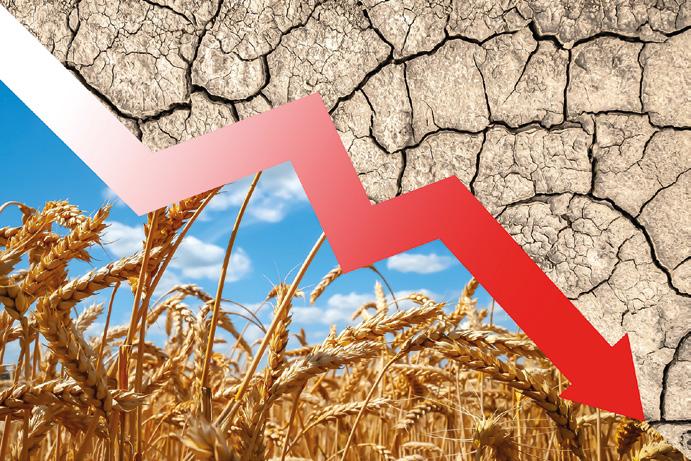
“More than a quarter of a billion people are now facing acute levels of hunger, and some are on the brink of starvation. That’s unconscionable,” UN SecretaryGeneral António Guterres wrote in the report’s foreword. “This sev-
enth edition of the Global Report on Food Crises is a stinging indictment of humanity’s failure to make progress towards Sustainable Development Goal 2 to end hunger and achieve food security and improved nutrition for all.”
According to the report, more than 40% of the population in IPC/ CH Phase 3 or above resided in just five countries – Afghanistan, the Democratic Republic of the Congo, Ethiopia, parts of Nigeria (21 states and the Federal Capital Territory - FCT), and Yemen.
People in seven countries faced starvation and destitution, or catastrophe levels of acute hunger (IPC/CH Phase 5) at some point during 2022. More than half of those were in Somalia (57%), while such extreme circumstances also occurred in Afghanistan, Burkina Faso, Haiti (for the first time in the history of the country), Nigeria, South Sudan and Yemen.
Around 35 million people experienced emergency levels of acute hunger (IPC/CH Phase 4) in 39 countries, with more than half of those located in just four countries – Afghanistan, the Democratic Republic of the Congo, the Sudan and Yemen.
Additionally, in 30 of the 42 main food crises contexts analysed in the report, over 35 million
58 italian food & packaging technology - civ (2023) - september NEWS
children under five years of age suffered from wasting or acute malnutrition, with 9.2 million of them with severe wasting, the most life-threatening form of undernutrition and a major contributor to increased child mortality.
While conflicts and extreme weather events continue to drive acute food insecurity and malnutrition, the economic fallout of the СOVID-19 pandemic and the ripple effects of the war in Ukraine have also become major drivers of hunger, particularly in the world’s poorest countries, mainly due to their high dependency on imports of food and agricultural inputs and vulnerability to global food price shocks.
Breakdown of key drivers:
Economic shocks (including the socioeconomic impacts of COVID-19 and the repercussions of the war in Ukraine) became the main driver in 27 countries with 83.9 million people in IPC/CH Phase 3 or above or equivalent –up from 30.2 million people in 21 countries in 2021. The economic resilience of poor countries has dramatically decreased over the past three years, and they now face extended recovery periods and less ability to cope with future shocks.
Conflict/insecurity was the most significant driver in 19 countries/territories, where 117 million people were in IPC/CH Phase 3 or above or equivalent. In 2021, conflict was considered the main driver across 24 countries/territories with 139 million people in these phases of acute food insecurity. The lower estimate is explained by the fact that economic shocks surpassed conflict as the main driver of acute
food insecurity in three countries still affected by protracted crises – Afghanistan, South Sudan and the Syrian Arab Republic. Weather/Climate extremes were the primary driver of acute food insecurity in 12 countries where 56.8 million people were in IPC/CH Phase 3 or above or equivalent, more than double the number of people (23.5 million) in eight countries in 2021. These extremes included sustained drought in the Horn of Africa, devastating flooding in Pakistan, and tropical storms, cyclones and drought in Southern Africa.
Looking ahead
Conflicts, national and global economic shocks and weather extremes continue to be increasingly intertwined, feeding into one
another and creating spiralling negative effects on acute food insecurity and nutrition. And there is no indication that these drivers will ease in 2023: climate change is expected to drive further weather extremes, the global and national economies face a grim outlook, while conflicts and insecurity are likely to persist.
According to 2023 projections available for 38 of the 58 countries/territories as of March 2023, up to 153 million people (or 18% of the analysed population) will be in IPC/CH Phase 3 or above. In addition, around 310 000 people are projected to be in IPC/CH Phase 5 across six countries – Burkina Faso, Haiti, Mali, parts of Nigeria (26 states and the FCT), Somalia and South Sudan, with almost three quarters of them in Somalia.
www.fao.org
The NOVA project develops the next generation of
antimicrobial coating technologies
The transmission of pathogenic microorganisms, such as bacteria, viruses or parasites, can happen rapidly with catastrophic and long-term consequences - as SARS-CoV-2, the virus responsible for the pandemic, has shown us. This situation is exacerbated by increasing antibiotic resistance. One potential solution to help control the spread of pathogens is a greater emphasis on surface hygiene in almost every facet of daily life. In the Next Generation BiOactiVe NAnocoatings (NOVA) project, 14 partners from 9 countries are
dedicated to developing market-ready solutions: Scientists and industry representatives are studying and testing highly efficient, environmentally friendly, and stable antimicrobial (antibacterial, antiviral, antifungal) coatings in order to reduce the risk of future microbial infections.
“
The corona pandemic has shown hygiene is paramount for our health. But we cannot rely on extensive chemical cleaning all of the time. We need new highly effective technologies, that are safe by design.”- says Anthonie Stuiver, senior scientist at AkzoNobel.
news italian food & packaging technology - civ (2023) - september 59
In NOVA, an interdisciplinary research team is working to develop at least four novel antimicrobial coatings for frequently touched surfaces in four specific application areas: public spaces, medical rooms, textiles, and touch screens. The development of each of these areas will be driven by an industrial partner from the consortium: AkzoNobel, Siemens Healthineers, SPARTHA Medical and Evonik. As an initial phase, the NOVA project aims to identify concrete challenges and use cases provided by industry partners. These challenges and use cases will serve as the foundation for the academic partners within NOVA to develop inno-
vative antimicrobial coating technologies. Leveraging data-driven insights, the researchers at Preste, aim to drive significant advancements in the field of antimicrobial coatings in a more rapid and efficient manner. In a final step, the product innovation experts at Dolmen Design and Innovation will ensure the availability of suitable application tools tailored to each final coating.
Together with partners Industrial Microbiological Services LTD and Manchester Metropolitan University, the antimicrobial surfaces and coatings will be tested and validated. As current methods do not provide robust, reproduci-
INTERNATIONAL EVENTS IN ITALY
24-27 October 2023 - Parma: CibusTec, food processing show - www.cibustec.it
16-17 January 2024 - Bologna: Marca, private label food showwww.marca.bolognafiere.it
20-24 January 2024 - Rimini: Sigep, confectionery, pastry and ice cream showwww.sigep.it
31 January – 3 February 2024 - Verona: Fieragricola, agricultural processing showwww.fieragricola.it
18-20 February 2024 - Rimini: BBTech, beer technology show - www.bbtechexpo.com
14-17 April 2024 - Verona: Sol&Agrifood, Italian food and olive oil showwww.solagrifood.com
14-17 April 2024 - Verona: Vinitaly, Italian wine show - www.vinitaly.com
19-21 April 2024 - Bologna: Cosmofarma, functional and nutraceutical exhibitionwww.cosmofarma.com
7-10 May 2024 - Parma: Cibus, food show - www.cibus.it
8-10 May 2024 - Rimini: Macfrut, fruit and vegetable processing exhibitionwww.macfrut.com
21-23 May 2024 - Milano: Packaging Première – luxury packaging showwww.packagingpremiere.it
28-30 May 2024 - Parma: SPS Italia – automation and digital show - www.spsitalia.it
28-30 June 2024 - Milano: Meat Tech, meat industry show - www.meat-tech.it
6-7 June 2024 - Parma: Solids, powder and bulk processing showwww.solids-parma.de
8-12 September 2024 - Rimini: IUFOST, world food science congress – www.iufost.org
12-15 November 2024 - Rho (MI): Simei, beverage and wine industry showwww.simei.it
8-11 May 2025 - Milano: Tuttofood, food show – www.tuttofood.it
27-30 May 2025 - Rho (MI): Ipack-Ima, packaging, food processing and pasta showwww.ipackima.com
ble data for real-life conditions, the NOVA team is also working on new antibacterial, antifungal, and antiviral testing methods for realistic and operational conditions.
A team of researchers from the Fraunhofer Institute for Ceramic Technologies and Systems, Empa, the University of Ljubljana and Inserm are working on adapting existing toxicity testing methods to the special requirements of coatings in order to obtain information on the safety of the coating materials. In addition, the focus is on sustainable product design.
The antimicrobial coating solutions offered by NOVA have different properties: Antimicrobial coatings from SPARTHA Medical are contact killing based and are made up of a layer-by-layer blend of water-soluble biopolymers. The three other antimicrobial coatings from Evonik, Fraunhofer Institute for Manufacturing Technology and Advanced Materials IFAM and Polymer Institute SAS, on the other hand, are triggered by visible or artificial light, and are based on different types of nanoparticles, with different function and antimicrobial activity.
About NOVA
NOVA is coordinated by DECHEMA Society for Chemical Engineering and Biotechnology. The project began on September 1st, 2022, and is scheduled to run for four years. The project is funded by the European Commission, the Swiss State Secretariat for Education, Research, and Innovation (SERI), and the UK Research and Innovation (UKRI) with around €7.5 million. More about the project at https://eu-nova.eu/
news 60 italian food & packaging technology - civ (2023) - september
A revolutionary almond paste

Di Bartolo S.r.l company is known for producing custom pastes suitable for all kinds of preparations. Our ability to fully customise these products has made it possible for our products to set the benchmark globally in the gelato, bakery, beverage and confectionery sectors for more than 70 years. Harvested from almond groves exclusively in the Val di Noto region, it is the key ingredient of the rich Almond Milk Paste produced by Di Bartolo. This high-quality, unique ingredient is creamy and 100% pure, making it ideal for companies that want to optimise their production processes while attaining high quality standards.
The extraordinary organoleptic and nutritional properties of the Almond Milk Paste from Val di Noto make it the ideal ingredient to be used for preparing plantbased products such as gelato, smoothies, yoghurts, creams, beverages, plant-based cheeses and sorbets, so as to meet the needs of all customers and of their target market. The Di Bartolo paste, which is naturally sugar and lactose free, is an ingredient
specifically designed to perfectly cater to the needs of an increasingly dynamic market that is constantly on the lookout for healthy and genuine products.
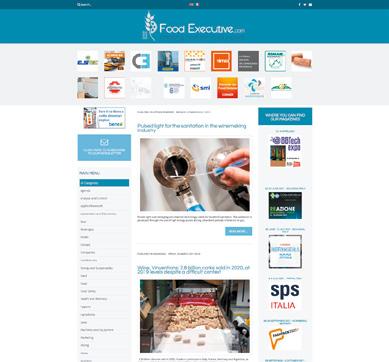

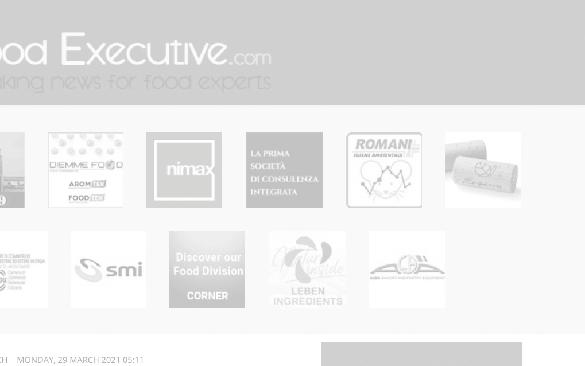
(Di Bartolo srl - Via Garibaldi 165 - 95011 Calatabiano - CT

- Italy - Tel. +39 095 645103
- email: info@dibartolosrl.itwww.dibartolosrl.it)


news italian food & packaging technology - civ (2023) - september 61
+ NEWS + INFORMATION www.foodexecutive.com FOODEXECUTIVE 1-4.indd 4 31/03/21 16:32
The meat industry will return to the spotlight in Milan in 2024
The MEAT-TECH exhibition (28-30 May 2024, Fiera Milano) will showcase a complete ecosystem of industry-leading processing and packaging technologies for the cold cuts, meat and ready meals sector along with ingredients, flavourings and spices. The
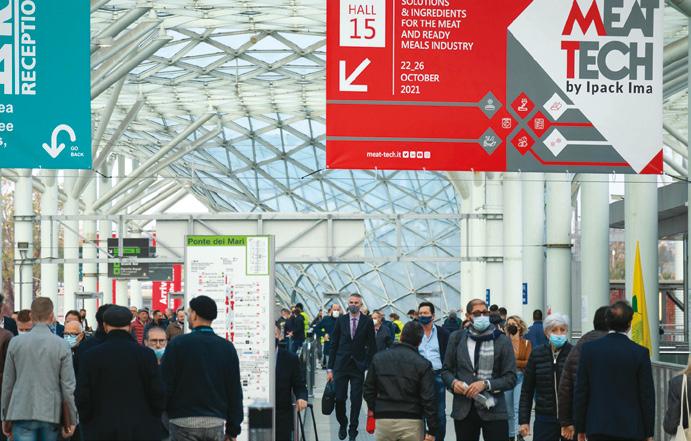
This latter segment will take centre stage at the new thematic exhibition PRO-TECH, which will complement the already extensive range of technology and solutions for meat processing and packaging that has always been exhibited at MEAT-TECH,
and an increased focus on plantbased alternatives such as soy, pulse and cereal products, as well as a boom in high-protein foods that are becoming increasingly sought after by retail outlets in response to growing consumer demand.
MEAT-TECH 2024 will therefore serve as a platform for the entire protein food market, combining the exhibition’s longstanding experience with its ability to respond to market dynamics driven by new lifestyles and consumption patterns that take an integrated view of meat and meat-like protein. The exhibition, part of the Ipack Ima network of trade fairs, represents a point of convergence between complementary industries and production chains, giving them the opportunity to share ideas and accelerate the pace of innovation.
show will focus in particular on complete meat processing plants featuring the latest filling machines, preparation lines, weighing, portioning, forming and extrusion systems, and dosing and cooking systems.
These versatile, high-performance production solutions meet the strictest food safety standards for meat products as well as innovative preparations for the vegetarian market. At this new edition of the show, industry professionals and innovative product development experts will have the opportunity to meet suppliers of technological solutions for both traditional and new protein-based products.
with a series of alternative ingredients and specific solutions for this emerging market.
PRO-TECH will be devoted entirely to new exhibition sectors such as fish, hard cheese, ready meals and pet food with a new focus on alternative proteins, plant-based foods, high protein foods and protein snacks.
The show will have a new formula and a positioning in line with the most significant market dynamics and meat consumption trends of the future. Key trends will include growth in demand for high-quality meat originating from sustainable, non-antibiotic-intensive animal farming
With its unique combination of traditional and alternative ingredients and additives for new formulations, the best food processing technologies, packaging materials and technologies, end-of-line solutions, labelling and traceability, refrigeration and washing systems, cleaning, hygiene and safety equipment, as well as automation and robotics, the show is a highly specialised B2B event and will be the sector’s only appointment in 2024.
MEAT-TECH and the new PROTECH section are organised by Ipack Ima and will be held in the Fiera Milano exhibition centre from 28 to 30 May 2024. The events will anticipate technological and production trends and explore the ways in which innovation and sustainability represent a springboard for the industry’s future development.
www.meat-tech.it
news 62 italian food & packaging technology - civ (2023) - september
Ipack-Ima Milano 2025: global technological excellence meets innovation
At the joint press conference, UCIMA and IPACK-IMA discussed the strategies behind the international exhibition’s development and provided an overview of the state of the Italian and global packaging industry.

Technological innovation, the international competitive scenario, a strong presence in key global markets, business models, sustainability and an innovative exhibition formula and organisational approach were the topics discussed in detail at the press conference in Düsseldorf organised by IPACK-IMA MILANO (to be held from 27 to 30 May 2025) and UCIMA (Italian packaging machinery manufacturers’ association).
“Today’s event offered a comprehensive overview of the state of the international packaging industry,” said Riccardo Cavanna, chairman of UCIMA. “We wanted to discuss topics relating to all areas of the industry so as to provide companies with a comprehensive picture of market trends. We also launched the We Make Packaging brand, which is intended to cover all the promotional
activities undertaken by Ucima for the Italian packaging industry, both in Italy and abroad. It marks a first step in our ongoing promotional strategy for a sector that represents Italian excellence worldwide.”
The press conference also discussed the development strategy adopted for the IPACK-IMA platform, conceived as an integrated and synergistic exhibition of the most innovative and important offerings in terms of technologies and materials, divided into four major areas of specialisation: grain based food, liquid food & beverage, pharma and chemicals. In addition, one of the real highlights of the show will be the sector of technologies and solutions for secondary and tertiary packaging, including the end-of-line stage, automation and robotics, coding and traceability systems.
“Over the coming years we will concentrate our efforts on expanding and innovating our range of offerings through Ipack Ima’s integrated platform,” said Valerio Soli, chairman of Ipack Ima . “We will look at the market and its future trends to help us successfully anticipate the needs of exhibitors and visitors from all over the world. In particular, we will focus on concepts such as digitalisation, technological innovation and sustainability, all of which are themes that are becoming increasingly topical and important for our industry. At IPACK-IMA MILANO 2025 we aim to provide exhibitors and visitors with all the answers they need to identify, strengthen and expand the business trajectories of the extraordinary companies present at the show, all of which represent the greatest capacity for innovation on a global scale.
“Our aim is to consolidate the IPACK-IMA of the future as an integrated platform of specialised and complementary trade fairs in order to foster a process of convergence which in turn will act as a business accelerator,” said Simone Castelli, CEO of Ipack Ima srl. “Our new strategy focuses on packaging technologies and materials for the target markets of the sectors hosted at the show, such as grain-based foods, beverage and liquid food, and pharmaceuticals.
www.ipackima.com
news italian food & packaging technology - civ (2023) - september 63

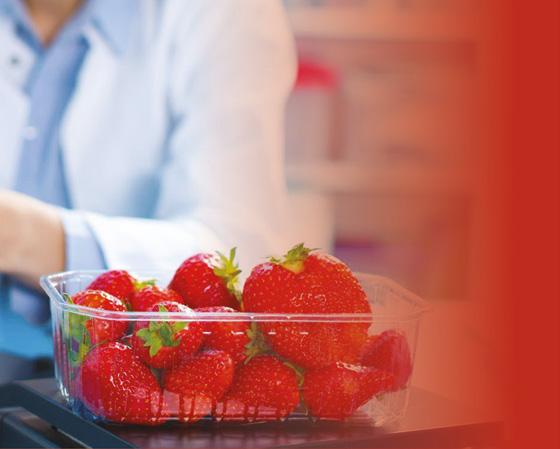






64 italian food & packaging technology - civ (2023) - september Company index Alba & Teknoservice - Villafranca Pad.www.albaequipment.it 51 CEPI - Forlì - www.cepisilos.com ................................................. cover 2 Foodexecutive.com - Pinerolo - www.foodexecutive.com 57 General System Pack - Schio - www.gsp.it .......................................... 9 Gerhard Schubert - Crailsheim (D) - www.schubert.group 37 IFP Packaging - Schio - www.ifppackaging.it..................................... 43 Ilpra - Mortara - www.ilpra.com cover 1 Italo Danioni - Milano - www.danioni.it .............................................. 21 Megadyne - Mathi - www.megadynegroup.com 17 Pinco - Rancate (CH) - www.pinco-sa.com .......................................... 47 TECNO 3 - Corneliano d’Alba - www.tecno-3.it cover 4 Tecno Pack - Schio - www.tecnopackspa.it ........................................ 27 Wolhfarth - Sordio - www.wolhfarth.it cover 3 Alba & Teknoservice 19 Ammega Italia ................................................................... 20 Bruno Wolfarth ................................................................. 14 CEPI 15 Di Bartolo 61 Gerhard Schubert 34 Ilpra 40 LM Group ............................................................................ 18 Pinco ................................................................................... 18 SMI 38 Tecno 3 22 Advertiser index www.chiriottieditori.it/en/ VISIT OUR SITE SUBSCRIBE TO OUR NEWSLETTER AND TO OUR SOCIAL MEDIA, WE WILL KEEP YOU INFORMED SITO CHIED 2018 1-2.indd 2 16/05/18 12:19
“RAPID” PUMPS
Sanitary - Self priming. Both for liquid and for thick products (Creams and Sauces).
“FARMINOX” FILTERS
Packingless plate filters. Working through paperboard filter-sheets.
made of stainless steel machined from bars, NO CAST PARTS, NO WELDINGS.

NEW BEGINNING! info@wolhfarth.it - www.wolhfarth.it V. Cavour, 31 - 26858 Sordio (LO) - Italy - Tel. +39 02 9810153 - Fax +39 02 98260169
DESIGN
THE MOMENT FOR A
HYGIENIC
for an easy cleaning SAFETY
FDA certified materials, suitable for the use in contact with foods. ENDURANCE
CONTINUOUS MELTING, IN A SINGLE PLANT AND IN A SMALL SPACE
COCOA AND CHOCOLATE MASS IN BLOCKS BLOCKS OF FAT, ANHYDROUS AND HYDRATED BUTTER


From today it is possible...
The innovative design of the FCD series continuous melter allows blocks of cocoa and chocolate mass, blocks of fat, anhydrous butter and hydrated fat (vegetable fat, dairy butter, etc.) to be processed in a single plant and is intended for the confectionery, dairy and food industries.
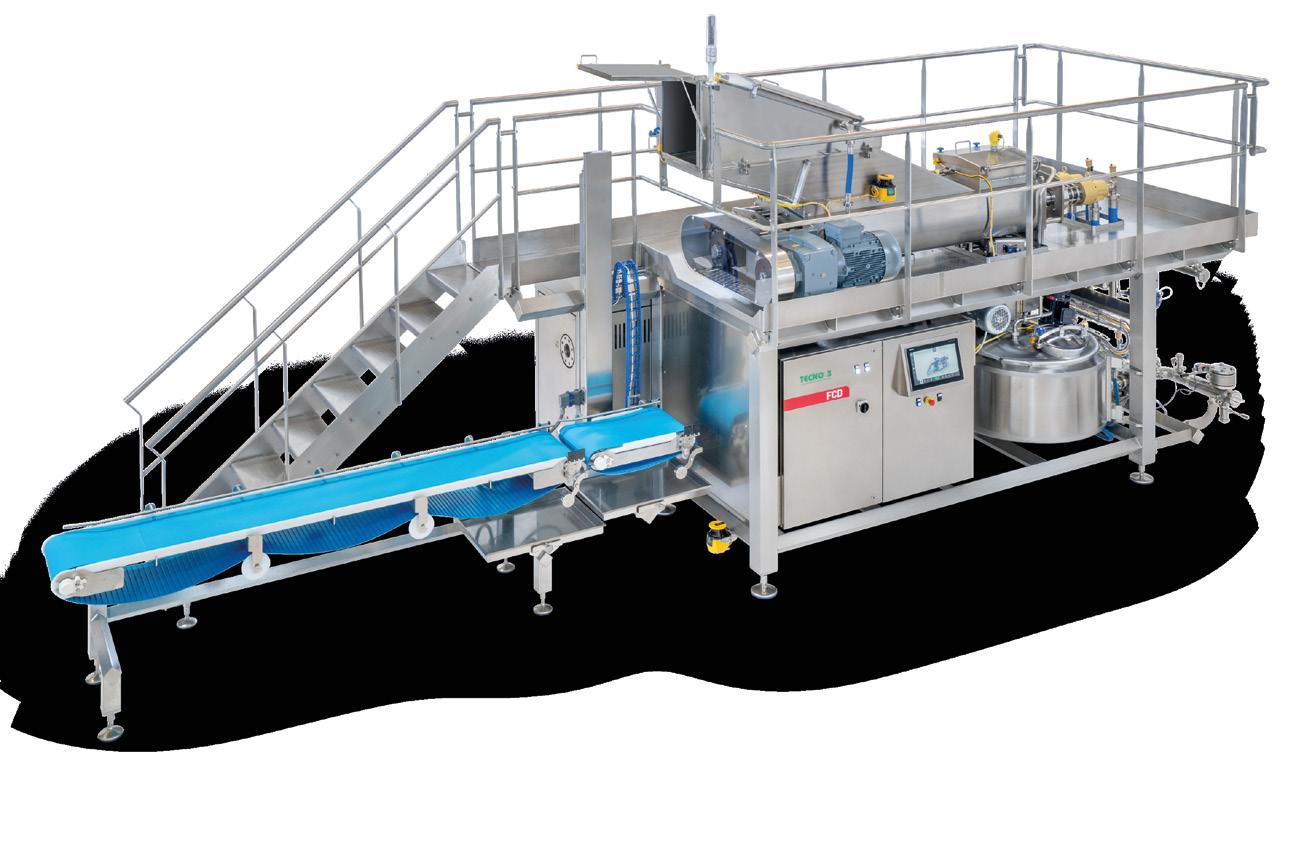
It is equipped with a special innovative system that guarantees high productivity, reduced energy costs and a saving in labour. The thermal exchange is highly efficient thanks to the mechanical work performed by hot rotors, which carry out a scraping action on the surface of the blocks.
Technological innovation, production optimization, power and security.
Headquarter:
+39 0173 61.05.64 • www.tecno-3.it
Tecno 3 S.r.l. - Corneliano d’Alba - ITALY Tecno 3 Switzerland Tecno 3 USA INC
TECNO 3 INAUGURATES THE NEW ERA OF CONTINUOUS MELTING









































 22-26 October 2023 Munich Booth 354 Hall C1
22-26 October 2023 Munich Booth 354 Hall C1






















































































































































